Australian
and international
exploratory
performance and
media arts
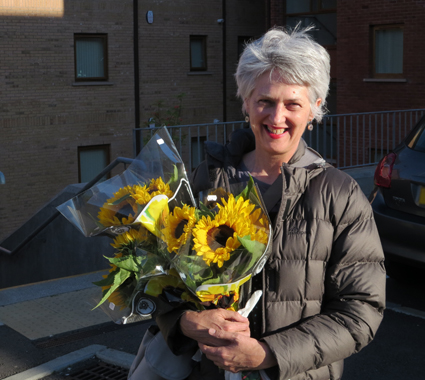
Anne Thompson
Bio
Anne Thompson has been a contemporary dancer, choreographer, tertiary level teacher, journal editor, academic, reviewer of dance with RealTime, dramaturg and director, primarily in visual and physical theatre with independent artists and small companies (Terrapin, Snuff Puppets, My Darling Patricia). She was a founding member of Dance Works and one of the founding editors of Writings On Dance. She has had an ongoing dramaturgical relationship with Garry Stewart and Daniel Jaber of Australian Dance Theatre as a dramaturg. In 2001 she co-founded the Eleventh Hour Theatre project in Melbourne with William Henderson. In 2008 they presented their version of Beckett’s End Game at the Melbourne International Festival and in 2010 their version of Shakespeare’s King John at the Adelaide Festival. Both were award-winners. In 2008 Thompson was appointed Director of the Drama Centre at Flinders University where she teaches directing in the program.
Anne writes: I love teaching. I like workshopping physical experiences and ideas with people. I like seeing how ideas and experiences sit with people and what they make them do. I have always found ideas and physical experiences liberating. Both can lead me to fresh thinking and a sense of rightness with myself and the world. I don’t dance much anymore but it still makes me happy when I do. I like being this age. I’ve done a lot of things in the performing arts and I am so much more relaxed doing any of them now. I’ve always pursued the experimental—the experiment of performance. I like examining performance and throwing caution to the wind. When I realised at 19 it was possible to interrogate performance I was excited. It made me realise it was possible to interrogate the performance in, and of, one’s life, though that realisation wasn’t so conscious at the time. I’ve never lost that. I have had so much fun interrogating performance with other people.
Exposé
I like writing about dance/performance because it makes me keep considering what artists are attempting and doing. I like to be respectful of that enterprise. I know as an artist and teacher it can be incredibly powerful to give people a way of describing experience. It can settle disquiet and liberate possibilities. When I review I like to honour the work artists do, attempt to describe that work and the action of that work on me. I am very committed to presenting the largest possible picture of what art can be and how it is occurring. I have always loved RealTime for presenting that. I started wanting to write about women and performance because I have many close, great relationships with women working in the field, many of whom are a lot younger than me. Graduates from the course in which I teach would ring me up and need to debrief about something that had happened to them. I wanted them to understand that what was happening was part of a bigger conversation so I set up a number of support groups where women working in performance could meet and talk and then I thought ‘why not make the conversation national?’
* * *
Anne is currently writing a series of articles titled Women + Performance for RealTime, with the intention of later compiling a book with other writers and RealTime on the current generation of women in Australian performing arts.
Women + Performance 1: Tessa Leong & Emma Beech
RealTime issue #115 June-July 2013 p38-39
Women + Performance 2: Anne-Louise Sarks
RealTime issue #116 Aug-Sept 2013 p6
Women + Performance 4: Kate Davis & Emma Valente, The Rabble
RealTime issue #117 Oct-Nov 2013 p28
See also her review of Leigh Warren's Not According to Plan in this e-dition
Coming up in RT118: An interview with POST prior to their 2014 Sydney Festival production for Belvoir, Oedipus Schmoedipus.
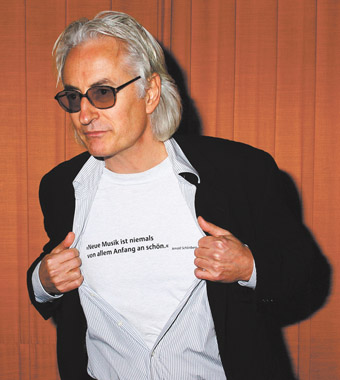
Jon Rose, “Neue Musik ist niemals von allem Angfang an Schön” (New music is never very nice at the beginning)
Jon Rose is perhaps one of the most prolific composer/musicians in Australia and thus appraisals of his deeds (and also his words) have often appeared in RealTime.
When Rose was announced as winner of the 2012 Australia Council Don Banks award, we filmed a conversation between him and improvisor and friend Jim Denley, offering an overview of his career, briefly summarised here:
“As well as being a consummate violinist and versatile improviser, [Jon Rose] has made a multitude of instruments and has also created many radio works. Most recently he has been exploring interactive music making experiences in works such as Pursuit, using musical bicycles (see RT90; RT96), an interactive netball game, Team Music! (RT96); and the multi-user festival hit The Ball project (RT102).
“Rose has also embraced the Australian landscape, evidenced in his Great Fences of Australia project undertaken with his partner, violinist Hollis Taylor, which saw the couple travelling across the outback playing and recording the sounds of Australia’s many fences. This journey is beautifully documented in a book by Taylor called Post Impressions (see RT82). Another epic adventure was the Ad Lib Project, an extensive archive of weird and wonderful music-making activities from around the nation, housed on the ABC’s website. It perhaps best illustrates Rose’s conflicted love for this country and its curious history which he enticingly articulated in his 2008 Peggy Glanville-Hicks address (RT83).” (Full article RT108)
Since that interview, more proof of his indefatigability, Rose has written a Currency Press Platform Paper on the place of live music in Australia (RT116), released a box set of a significant selection of his works, Rosin (RT115), mounted a collaborative tour with young improvising musicians to the Corner Country of NSW (RT112) and shared his wisdom with new music group Atticus (RT111). Most recently he’s been turning bicycles into musical instruments in the largest version of his Pursuit project to date as part of the Canberra100 celebrations, an account of which he shares with us in our 20 Nov edition (link).
Jon Rose will perform as a soloist with the Adelaide Symphony Orchestra in Program 1, March 9, of Tectonics Adelaide, curated and conducted by Ilan Volkov, in the 2014 Adelaide Festival (see the festival preview in RT119).
Overviews
RealTime TV: Composer Profile, Jon Rose
In conversation with Jim Denley
RealTime issue #108 April-May 2012 web
Jon Rose: Australia Made Extraordinary
Jim Denley Talks With Jon Rose, Don Banks Music Award Winner 2012
RealTime issue #108 April-May 2012 p34-35
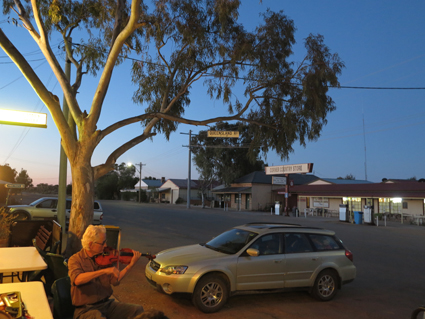
Jon Rose in Tibooburra
photo Lucas Abela
Jon Rose in Tibooburra
Music articles & reviews
Jon Rose, Rosin
Chris Reid, CD review
RealTime issue #115 June-July 2013 p46
On the road with Rose
Rishin Singh: Jon Rose’s Sound Circus
RealTime issue #112 Dec-Jan 2012 p42
No Strings Attached
Simon Charles: Jon Rose, Atticus & Guests: Metapraxis
RealTime issue #111 Oct-Nov 2012 p48
The sound of bicycles singing
Shannon O’neill: Jon Rose & Robin Fox, Pursuit
RealTime issue #90 April-May 2009 p48
Looping & shimmering
Andrew Harper: MONA FOMA Festival of Art & Music, Hobart
RealTime issue #96 April-May 2010 p40
New music: challenge as fun
Matthew Lorenzon, Mona Foma, Hobart
RealTime issue #102 April-May 2011 p5
Vigorous exercise & a well-balanced diet
Gail Priest: The Now Now Festival 2010
RealTime issue #96 April-May 2010 p39
The shame of growing old gracefully
Gail Priest: What Is Music? Sydney
RealTime issue #94 Dec-Jan 2009
Making instruments, ears, audiences
Gail Priest surveys the issues and events of the REV festival
RealTime issue #49 June-July 2002 online exlusive
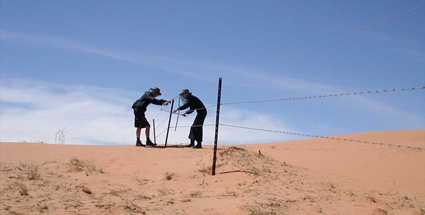
Jon Rose & Hollis Taylor, play a fence in the Strzelecki
Writings
Sound, Speed, Rust and Re-cycling
Jon Rose: an account of The Canberra Pursuit
RealTime issue #116 Aug-Sept 2013 web
Past reclamations, future provocations
Julian Knowles, Jon Rose’s The Music of Place: Reclaiming a Practice
RealTime issue #116 Aug-Sept 2013 p48
Music denied a voice
Jon Rose, City Conversation 2013, City of Sydney, 26 June
RealTime issue #115 June-July 2013 web
Post impressions
Hollis Taylor’s book about an epic fence-playing journey
RealTime issue #82 Dec-Jan 2007 p40
Listening to history
Jon Rose’s 2007 Peggy Glanville-Hicks Address
RealTime issue #83 Feb-March 2008 p46
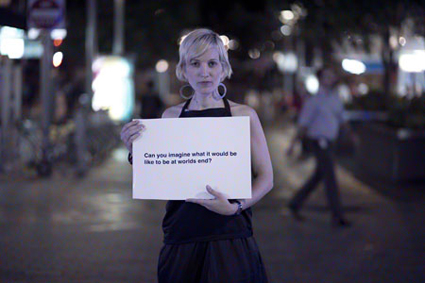
Sarah-Mace Dennis, Do you protest in silence (work in development)
courtesy the artist
Sarah-Mace Dennis, Do you protest in silence (work in development)
Histories, ghosts and memory are consistent themes throughout Sarah-Mace Dennis’ interdisciplinary practice, involving text, photomedia, performance and video. I first came across Dennis’ work in 2004 when she was collaborating with Svenja Kratz on a series of projects inspired by the historic goldmining town Hill End in regional NSW.
A story of infanticide and suicide, To Rose (my Love) (2004-5), was an interactive video installation in which the viewer’s shadow falling on the screen in the gallery revealed ghosts hidden within the image. The culmination of the series was the hypermedia work Di.O.ram.a: Constructing a Virtual Memory (2007), a journey of image and text uncovering real and imagined stories from the town circa 1872. These early works were impressive for their blending of both real and imagined histories and their technically ambitious formats.
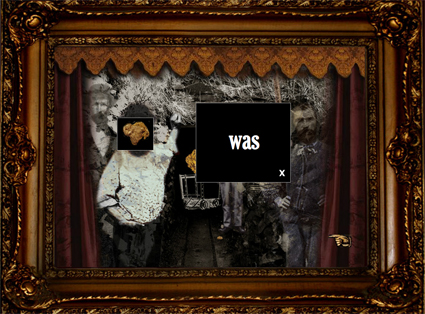
Sarah-Mace Dennis & Svenja Kratz, Di.O.ram.a: Constructing a Virtual Memory (2007)
courtesy the artists
Sarah-Mace Dennis & Svenja Kratz, Di.O.ram.a: Constructing a Virtual Memory (2007)
Shared histories, public memories
Dennis’ most recent work continues these earlier preoccupations but on a much larger scale, thanks to a series of public art commissions. The first of these was Moving over the shoreline, commissioned by art+place (2007-2012), the body responsible for managing the funds raised from compulsory cultural contributions levied on new commercial building development projects in Brisbane. Moving over the shoreline is a two screen, permanent video projection on the façade of the Queensland Multicultural Centre, drawing on historic and contemporary stories about immigration and particularly inspired by Yunguba House, the Brisbane immigration depot in the 19th and 20th centuries.
Dennis interviewed people who had lived at the depot when they first arrived in Australia, as well as more recent immigrants. She also worked with local ethnic dance groups. She says, “I decided I was going to work with ethnic dance groups which might have been a strange decision [for a contemporary art project] but it made complete sense to me because I used to be a Scottish dancer and I know how those traditional dance forms are punctuated by narratives that belong to the traditions. I also wanted to have some Indigenous representation in the work, so I was really lucky to be connected with the dance group Nunukul Yuggera. I only really controlled [the shape of the work] or scripted it from colonisation onwards; so I told the group how my work was evolving across the two screens and then we worked together on how they wanted their story to be told in that.”
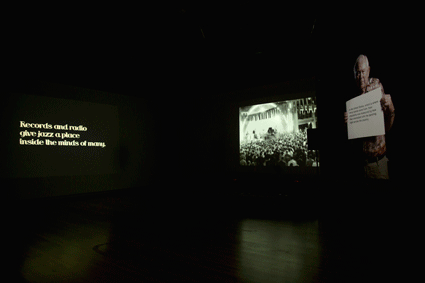
Sarah-Mace Dennis Sounds from the Emergent State, commissioned by the State Library of Queensland for the exhibition Live! Queensland Band Culture.
courtesy the artist
Sarah-Mace Dennis Sounds from the Emergent State, commissioned by the State Library of Queensland for the exhibition Live! Queensland Band Culture.
Dennis’ most recent commission is her most ambitious to date. For the State Library of Queensland’s exhibition Live! Queensland Band Culture, Dennis created the six-channel video installation Sounds from the Emergent State. For this exploration of the relationship between music, politics and social and cultural change in Queensland from WWII to the end of the 90s, Dennis used archival footage and interviews with people from the music industry, also getting them to ‘perform’ their responses in the style of Bob Dylan’s “Subterranean Homesick Blues.” She explains, “Queensland is so amazing in terms of music I did feel overwhelmed at first. I thought I can’t possibly tell this story myself, it’s the story of all these amazing musicians who’ve lived in this state. I wanted them to perform in the work because I wanted to acknowledge the people who’ve been working so hard and making those contributions behind the scenes.”
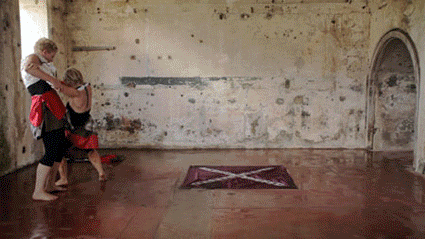
Sarah-Mace Dennis, Mondo Ghilles (2010)
courtesy the artist
Sarah-Mace Dennis, Mondo Ghilles (2010)
Personal histories, embodied rememberings
In terms of the way these stories unfold Dennis believes, “the best way to tell history is by dispersing it across multiple frames, fragmenting it so that viewers are getting traces and they’re putting it back together through their own bodies, by the way they move through things or the way they connect things perceptually.”
Dennis knows first hand what it’s like to piece fragments of history, her own history, back together. In 2008 she was involved in a car accident resulting in a severe brain injury. After time in a coma, she awoke paralysed and with amnesia. Over an intensive period of rehabilitation she regained the use of her faculties and she has made several works that explore this experience of re-embodying and re-discovering her “self.”
For the 2010 Next Wave festival Dennis was commissioned to make a dance film for Nat Curiso’s Private Dances. As part of her rehabilitation, Dennis went back to Scottish dancing (at 15 she’d been competing at championship level). Mondo Ghillies mixes this form with a kind of Vivienne Westwood baroque punk visual aesthetic resulting in a haunting short film. “Mondo Ghillies was about developing my film practice at the time and experimenting with dance film. But in that project I was still very inside the experience. It’s still dealing with the trauma of waking up and being paralysed and not being about to think as you used to.”
Dennis’ Swallow, currently in development, offers a different perspective on the experience. “Since Mondo Ghillies I have done a lot of writing about the event, so Swallow is from a [more reflective] position. The work has multiple characters that I play myself. The idea is that these are really ghosts of myself that I became during my recovery. With a brain injury you go through these really remarkable changes where you think, ‘My brain is functioning again, I’m back to normal.’ But it’s a little bit like the feeling I had when I was a teenager when I thought, ‘Now I’m grown up.’ A year later I looked back and went, ‘Wow, I just didn’t know anything then’…The work really is reflecting on what it means to be a person with no brain, how that challenges your perceptual frameworks and your identity—how you even come to comprehend existence.” Heath Ledger also has a ghostly cameo: Dennis, while in her coma, seemed to absorb the news of the actor’s death, knowing this fact on waking.
Dennis has also written extensively on these experiences as part of her Masters in film theatre and media (UNSW, 2013); she’s currently completing a text for which she’s keen to find a publisher. I asked her about the relationship she sees between her writing and her moving image work, which is often more corporeally based. She explains, “I trained in creative arts, majoring in writing, contemporary visual art and theory—so that’s very much how I approach my work, through these intersecting mediums. I think what I’ve always done is begin with a conceptual or philosophical idea and use my practice as a way of exploring that through a form that isn’t language, because you can’t do everything with writing…[then] I write about that at the end [of the process], in this ficto-critical way where I’m using the story of my experience of making the work to talk about how it’s changed or extended the conceptual idea or theoretical idea that I’ve been thinking about.”
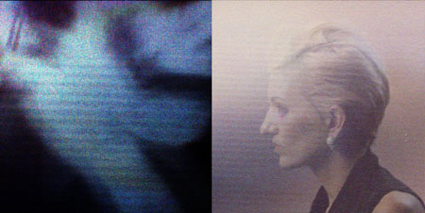
Sarah-Mace Dennis, Swallow (currently in development)
courtesy the artist
Sarah-Mace Dennis, Swallow (currently in development)
Art and social responsibilities
As well as Swallow, Dennis is working on a large-scale video project, Do you protest in silence?, which indicates a shift of focus from historical to contemporary social reflection. Through her experiences making Sounds from the Emergent State, Dennis has become increasingly interested in how music and art inspire social change. She has recently moved to London via New York where she met up with filmmaker Antonino D’Ambrosio whose recent documentary Let Fury have the Hour explores how artists can elicit “creative responses” from people that dramatically effect culture as a whole. Dennis hopes to continue her dialogue with D’Ambrosio as she works on her video project.
In a follow-up email Sarah-Mace Dennis writes, “I think being outside of Australia has been quite important. Being in a new place has given me more courage to find my voice on bigger issues that affect the world on a global level… [Do you protest in silence?] is still about consciousness and the brain, but it is also about how creative ideas really have the potential to affect the way we think about and live in the world.”
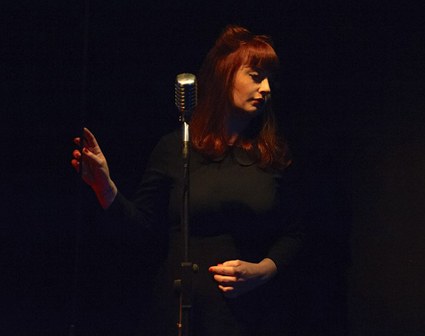
Rachael Dease, City of Shadows, Malthouse’ Helium program
photo Sarah Walker
Rachael Dease, City of Shadows, Malthouse’ Helium program
The 2008 rock documentary Something in the Water by Aidan O’Bryan suggested something elemental makes such a small city so musically productive. What’s particularly interesting about the Perth music scene is not just the number of high calibre bands and musicians that emerge from it but the fluidity with which these artists move between genres and musical scenes. Composer-musician-director Rachael Dease is a perfect example of this.
Since graduating with a Bachelor of Performing Arts (Music) from WAAPA (perhaps some of that secret watery ingredient comes from the quality of music education in Perth) Dease has been active on the Perth pop scene as a solo artist and in the band Schvendes, her versatility becoming evident when she won both the the WAM Pop Song of the Year and Experimental Song of the Year in 2010. She’s also been involved in contemporary classical music and theatre worlds creating soundtracks and performing live in a number of successful stage productions. Most recently she has created her own music theatre work, City of Shadows, taking the 2012 Perth Fringe World by storm (winning the Western Power Martin Sims Award for Best Overall Performance for Best Musical Work). The work has since enjoyed an encore season at Fringe World 2013, toured to the New York Fringe and was part of Malthouse’s Helium season.
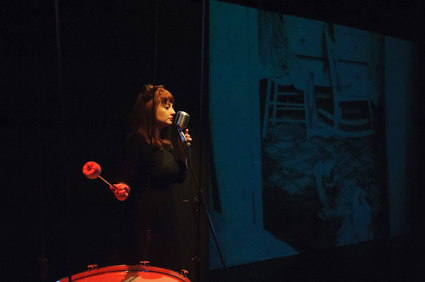
Rachael Dease, City of Shadows, Malthouse’ Helium program
photo Sarah Walker
Rachael Dease, City of Shadows, Malthouse’ Helium program
Accidental performer
I asked Dease why she thinks Perth musicians are so adaptable. “A lot of us with different backgrounds or different disciplines associate socially, so we sometimes come up with concepts that we wouldn’t if we were living anywhere else…I think that a lot of us want to branch out a little bit and there isn’t as much dedicated work for specific disciplines here, so composers here do tend to actually write quite well for dance and theatre and film, whereas those might be more niche areas in larger cities.”
Perhaps the most surprising thing about Dease’s current career is that she never really considered herself a singer or performer. “At first I would have liked to have done more film work. That was the dream of the young artist me. I think that’s why I’m drawn to theatre—the magic that happens there. But I never set out to be a performer by any means. I wanted to compose for other people. I’m pretty much an untrained singer so I didn’t think I had a real right to be on the stage. [But] it happened and I was there and it worked. I found I had something I didn’t realise I had and since then I’ve been using that in my work.”
Dease started her involvement with theatre when she was invited to create the score and perform live in Matthew Lutton’s acclaimed Antigone (see RT90). Subsequently she was invited to collaborate on It’s Dark Outside, the puppetry and illusion-based theatre work presented by Perth Theatre Company which has since toured nationally and internationally, (RT109, RT113.) Dease says that the collaboration with the show’s creators, Arielle Gray, Chris Isaacs and Tim Watts, was something “that came about really organically. They heard some of my songs and came up to me at a Fringe gig and said let’s start working together and that really pushed me in a new direction.”
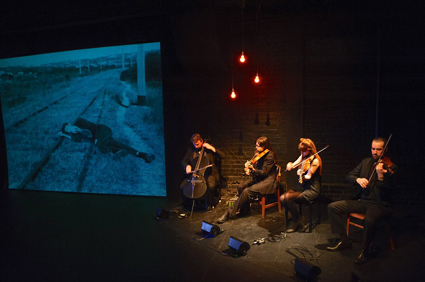
Tristen Parr, Aaron Wyatt, Hayley-Jane Ayres, Brian J Kruger, City of Shadows, Malthouse’ Helium program
photo Sarah Walker
Tristen Parr, Aaron Wyatt, Hayley-Jane Ayres, Brian J Kruger, City of Shadows, Malthouse’ Helium program
Out of the shadows
That new direction resulted in Dease having the confidence to create her own music theatre show, City of Shadows, which premiered at the 2012 Perth Fringe World. The piece is an intimate song cycle performed by Dease and a string quartet, inspired by the collection of forensic photographs held by the Justice and Police Museum (the same archive well deployed by Ross Gibson and Kate Richards in their media art work, Life After Wartime, RT34, RT80). Dease was shocked at how well the work was received. When the offers started coming in she had to decide whether she thought this quite personal work, which she describes as “an exorcism” of sorts, was something she felt comfortable continuing. “I was very concerned when we premiered the piece in Perth that people wouldn’t understand that I was in no way wanting to exploit these images or use them to gain anything in any other way than to project a message. I guess I felt safe doing that in Perth because I had a reputation here and people understand that that’s not the kind of artist I am. But then all of sudden I got offers to take it to New York and then Melbourne—I don’t have that [reputation] there and I was concerned. But to my complete joy, 99% of people have understood what it is about.”
Accompanied by the highly evocative images, the cycle has a loose interlinking narrative but features separate sections that Dease says focus on “particular victims or particular perpetrators. And there’s a whole section largely dedicated to the detectives themselves.” Dease chose to accompany herself with a string quartet (Brian J Kruger, Hayley-Jane Ayres, Aaron Wyatt, Tristen Parr). “I write for strings quite a lot so it was something I could rely on, that this particular sound was going to suit these images. As a lot of it is largely improvised with the strings, I knew the performers that I wanted and I knew they’d interpret these notes and songs and these images the way I wanted them to.”
In City of Shadows Dease realised she’d slipped into another role she’d never really planned, that of director. So to investigate this further she applied for The Besen Associate Artist Program at Malthouse Theatre, Melbourne undertaking a one month residency in July 2013. She split her attention between working “with Jethro Woodward in sound design, Matthew Lutton in directing and David Chisholm in composition. So I got more of a handle on that style of communication between professionals and how music can sit live and pre-recorded in a theatre setting and how a director deals with those kinds of things.”
(Listen to City of Shadows here
Watch City of Shadows trailer here.)
Keeping her ear in
While Dease has been working in theatre she hasn’t neglected her compositional skills in “art music.” Her impressive 40-minute composition 4 part history (listen here), was part of the site-specific sound installations Dialogues with Landscape, commissioned by 2011 Perth International Art Festival and the UWA Cultural Precinct. She’s also just completed a commission for Perth new music ensemble Decibel. Dease comments, “I would like to do a few of those kinds of works a year. I think they push me in a different direction and make me think more about things, especially when I’m given an instrumentation (not choosing one); that really makes me work hard for it and I really enjoy it in the end.”
But it does seem that the lure of the theatre is becoming stronger. Dease is currently thinking about a new show that will take one of the characters from City of Shadows and continue her story. “I think I’m definitely going down the path of using songs in interesting ways in theatre. I’m still trying to explore that and figuring out the best way it can be done.” She feels that collaboration is a real key and that she needs to seek more of this interstate. “As much as I really love working in Perth, I’ll have to continue to duck out, almost on a monthly basis. I enjoy meeting new people and bouncing new ideas [around]. For someone who burrows themselves away in their cave some times, it’s nice to have that feeling of creative unity with another artist.”
The last in the loop for the year and it’s actionpacked. As it’s so huge we’ve made artform sections for easy browsing. Dive in…
PERFORMANCE | DANCE | VISUAL/MEDIA ARTS | MUSIC | FILM
PERFORMANCE
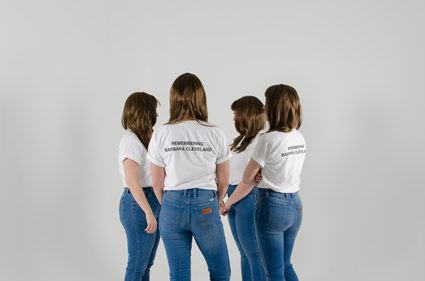
This is Barbara Cleveland, Brown Council
photo Lucy Parakhina
This is Barbara Cleveland, Brown Council
You’re History: Performance Space 30th Birthday
The Performance Space birthday bash promises to be enormous, with multiple events every night for 10 days including new works by Tess de Quincey, Nigel Kellaway, Ros Crisp and Brown Council, compilation re-mixes from most Performance Space directors and the TeleVisions festival.
For all the info read our interviews with directors Bec Dean and Jeff Khan and Brown Council.
You’re History: Performance Space 30th Birthday, Carriageworks, 20 Nov 1 Dec; http://www.performancespace.com.au/
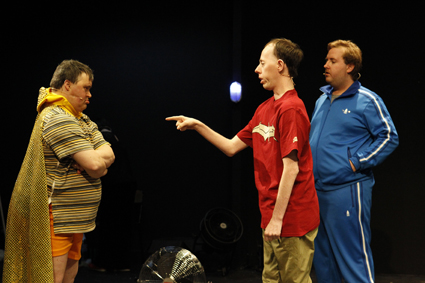
Mark Deans, Simon Laherty and Brian Tilley, Super Discount, Back to Back Theatre
photo Jeff Busby
Mark Deans, Simon Laherty and Brian Tilley, Super Discount, Back to Back Theatre
Super Discount, Back to Back, Malthouse
Following its Sydney Theatre Company premiere, Back to Back’s Super Discount is now in the middle of its Melbourne season at Malthouse. In RT117 Keith Gallasch wrote, “audition routines, debates, role playing…witty scripting and a strong focus on trust…all add up, delivering a satisfyingly complex and richly entertaining experience.”.
Back to Back Theatre, Malthouse Theatre and Sydney Theatre, Super Discount, Merlyn Theatre, The Cooper’s Malthouse, 13 Nov-1 Dec; http://www.malthousetheatre.com.au/show-listing/super-discount/
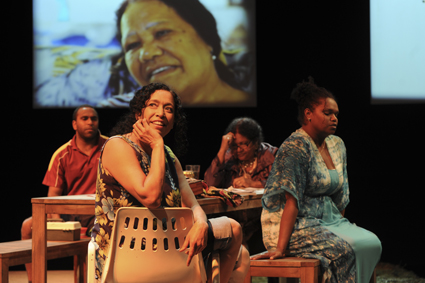
Harry Reuben, Rachael Maza, Magdalena Blackley, Kylie Doomadgee, Beautiful One Day, Ilbijerri, version 1.0 & Belvoir
photo Heidrun Löhr
Harry Reuben, Rachael Maza, Magdalena Blackley, Kylie Doomadgee, Beautiful One Day, Ilbijerri, version 1.0 & Belvoir
Beautiful One Day, Ilbijerri Theatre Company, version 1.0, Arts House
After last year’s successful premiere season at Belvoir, Beautiful One Day has its Melbourne debut at the Arts House, North Melbourne Town Hall. In his review in RT113 Keith Gallasch wrote, “This account…digs into the island’s history and adds a heightened Indigenous perspective side by side with verbatim recreations of pivotal moments in the unfolding tragedy.”
Beautiful One Day, Ilbijerri Theatre Company, version 1.0, Arts House, North Melbourne Town Hall, 26 Nov-1 Dec; https://www.melbourne.vic.gov.au/ArtsHouse/Program/Pages/BeautifulOneDay.aspx
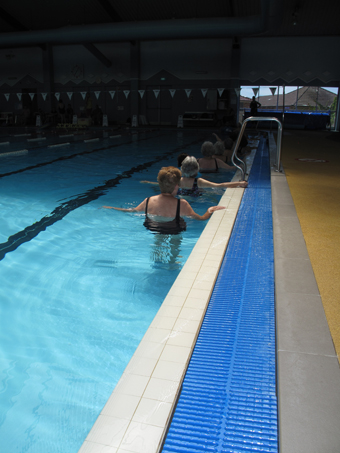
Birthing Things in the Spirit: The Water Birth, David Capra
courtesy the artist
Birthing Things in the Spirit: The Water Birth, David Capra
Birthing Things in the Spirit: The Water Birth, David Capra, Campbelltown Arts Centre
David Capra is interested in “intercessions,” art experiences that initiate healing and spiritual enlightenment. Currently he’s working with the ladies from the over 50s aquatic group at Eagle Vale pool in Sydney’s southwest to create a “water birth of the spirit,” with some stylistic inspiration from Australia’s own inventor of synchronised swimming, Annette Kellerman and Hollywood’s Esther Williams. The results of the month-long exploration are open to the public.
Campbelltown Arts Centre: Birthing Things in the Spirit: The Water Birth, David Capra, Eagle Vale Central, Campbelltown (Aquatic Centre); 30 Nov, 6pm; http://www.campbelltown.nsw.gov.au/Dance
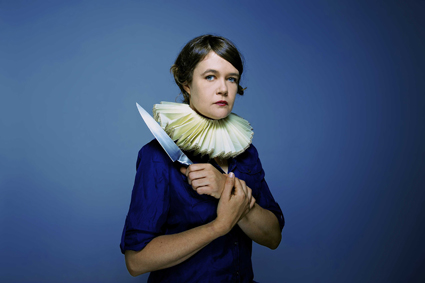
The Hayloft Project, Arden vs Arden
photo Sarah Walker
The Hayloft Project, Arden vs Arden
Arden vs Arden, The Hayloft Project
Melbourne indie theatre collective The Hayloft Project is about to relocate to Sydney but they’re having one last hurrah with their production Arden vs Arden. Directed by Benedict Hardie this adaptation of Arden of Faversham, an Elizabethan tale of bloody murder and betrayal, occurs in both a contemporary Australian and historical context, with some blurring along the way. (See our interview with Anne-Louise Sarks, collaborator with Hardie and Hayloft)
Darebin Arts Speakeasy presents The Hayloft Project’s?Arden v Arden?, 20 Nov-8 Dec, http://darebinarts.com.au/event/arden-v-arden-by-the-hayloft-project/
DANCE
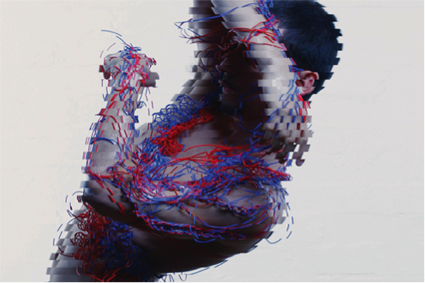
Aorta, Stephanie Lake, Chunky Move
courtesy the company
Aorta, Stephanie Lake, Chunky Move
Aorta, Stephanie Lake, Chunky Move
It’s been a prolific year for Stephanie Lake with premieres of four major works including Dual in Dance Massive (see review and rt tv interview); Axial in Frontier Danceland, Singapore; A Small Prometheus in the Melbourne Festival (to be reviewed in RT118); and now Aorta for Chunky Move. This is Lake’s second commission for the Next Move program and sees her choreographing for three male dancers, exploring the body’s interior secrets, to a score and lighting system by Robin Fox.
Aorta, Stephanie Lake Chunky Move Studios, 22-30 Nov; http://www.chunkymove.com/Our-Works/Next-Move/AORTA.aspx
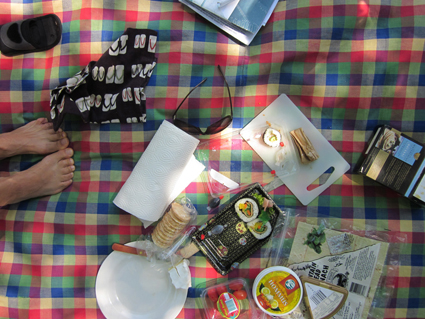
Nat Cursio’s CRITNIC
courtesy the artist
Nat Cursio’s CRITNIC
CRITNIC, Nat Cursio
Nat Cursio’s latest venture combines a picnic with some stimulating critical chat about dance. It’s “similar to a book club, but instead of talking about books we’ve read, we’ll talk about dance performances we’ve seen” (press release). And while actually held inside, there’ll still be picnic rugs and snacks.
CRITNIC, Lucy Guerin Studio, 24 Nov 2pm; http://www.trybooking.com/Booking/BookingEventSummary.aspx?eid=67448
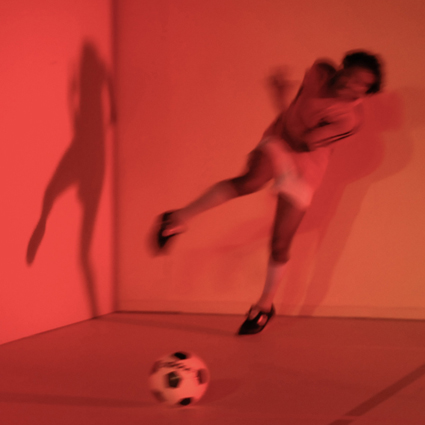
Ahilan Ratnamohan, SDS1
photo Heidrun Löhr
Ahilan Ratnamohan, SDS1
SDS1, Ahilan Ratnamohan, PICA
Following his well-received solo theatre work The Football Diaries, ex-professional soccer player now performer Ahilan Ratnamohan is presenting a solo dance work at PICA. SDS1 is inspired by the physicality of the game and its attendant issues of “efficiency versus artistry, result versus style, and the psyche of vulnerable warriors” (website).
SDS1, Ahilan Ratnamohan, PICA, 27-30 Nov, http://www.pica.org.au/view/SDS1/1753/
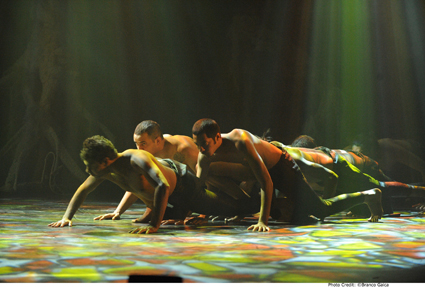
Ngalpun Mudth (Our Home), NAISDA Indigenous Dance Showcase
photo Branco Gaica
Ngalpun Mudth (Our Home), NAISDA Indigenous Dance Showcase
Ngalpun Mudth (Our Home), NAISDA Indigenous Dance Showcase
Forty dancers undertaking training at NAISDA will profile their achievements in an evening of works choreographed by nine professional choreographers including Vicki Van Hout, Sani Townson, Frances Rings and Gary Lang, along with two pieces by emerging student choreographers.
Ngalpun Mudth (Our Home), NAISDA Indigenous Dance Showcase, Carriageworks, 11-14 Dec; http://www.carriageworks.com.au/?page=Event&event=NAISDA-END-OF-YEAR-SHOW
VISUAL/MEDIA ARTS
Melbourne Now, NGV
The absolutely epic Melbourne Now is about to launch, featuring the work of over 400 artists exhibited across both sites of the National Gallery of Victoria. Special commissions include a new sound and light installation from Marco Fusinato; a video commission from Daniel Crooks focusing on Melbourne’s laneways; and an icing-covered share house constructed by the Hottham Street Ladies artist collective. Lucky it’s on for four months—it might just take that long to see everything.
Melbourne Now, NGV; 22 Nov – 23 March; http://www.ngv.vic.gov.au/whats-on/exhibitions/exhibitions/melbourne-now
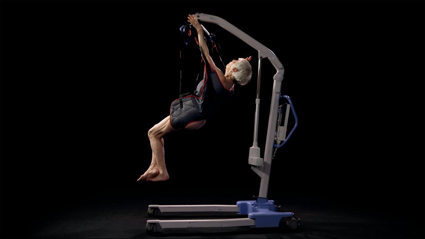
Kate Murphy, Lift, 2013, single-channel HD video with sound
courtesy the artist
Kate Murphy, Lift, 2013, single-channel HD video with sound
Lift, Kate Murphy, Breenspace
Video artist Kate Murphy has a new work, Lift, soon to be exhibited at Breenspace. Inspired by her experiences visiting her father in an aged care facility, Lift places a dancer’s body in a mechanical patient lifting mechanism in a poignant exploration of the “relationship between the cognitive and the subconscious self, and the ‘dances’ we perform everyday” (press release).
Lift, Kate Murphy Breenspace, 29 Nov-21 Dec; http://www.breenspace.com/exhibitions/kate-murphy/katemurphy_lift_2013_still2.jpg.php
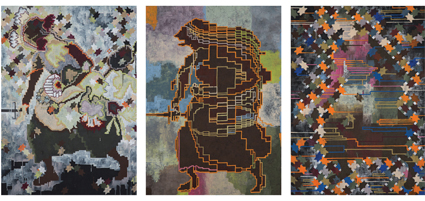
Ruth Walller, Dulle Griet (2013) acrylic on linen, Insight Radicals
courtesy the artist
Ruth Walller, Dulle Griet (2013) acrylic on linen, Insight Radicals
Insight Radicals: MCLEMOI Gallery
Tony Lloyd, Steve Lopes, Anna Madeleine, Natalie O’Connor, Peter Sharp and Ruth Waller have undertaken a year-long residency at the ARC Centre of Excellence for Free Radical Chemistry and Biotechnology at the University of Melbourne. The results of their fascination with free radicals, in our bodies and materials, will be exhibited at MCLEMOI gallery, touring to Adelaide in 2014. Expect “luminous light media, sci-fi landscapes, sound activated paintings and water colour portraits” (press release).
Insight Radicals, 27 Nov-9 Dec; http://mclemoi.com/portfolio-view/insight-radicals/
Archana Hande artist talk, spaced
Spaced (formerly IASKA) offers opportunities for international and Australian artists to undertake in-depth residencies in regional areas of Western Australia culminating in a biennial exhibition (see RT108, http://www.realtimearts.net/article/issue108/10599). Visiting Indian artist Archana Hande will be presenting an artist talk at the spacedHub in Perth about her recent experiences in Laverton looking at “local histories and stories that trace existing contested terrains concerning tradition, trade and migration” (website).
Archana Hande artist talk, spacedHUB, Perth, 21 Nov; http://www.spaced.org.au/posts/news/
SOUND/MUSIC
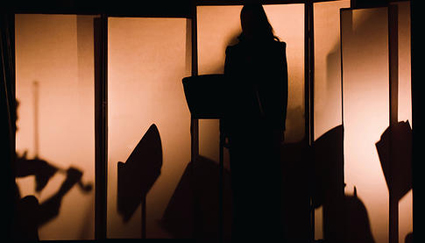
Corridor, CACHE in POINT
courtesy the artists
Corridor, CACHE in POINT
Corridor, CACHE in POINT
The curators of Cache in Point, soprano Sonya Holowell and flautist Elia Bosshard, are keen to create new experiences for music audiences employing interdisciplinary collaborations to “break down the seeming barriers between audience and performer, music and non-music, and pre-composed and spontaneous music.” The second in their series takes place in a corridor and features compositions by Andrew Ford, Iannis Xenakis, Gyorgy Kurtag and Austin Buckett.
Corridor, CACHE in POINT; Level 3 Corridor, Robert Webster Building, UNSW, 29-30th Nov; http://www.cacheinpoint.com/#!upcoming/galleryPage
West Head Project & Peggy Glanville Hicks Address, New Music Network
The West Head Project revels in music making in alternative environments (initially bushland at West Head on Sydney’s north shore). This year the project profiles woodwind players Jim Denley and Rosalind Hall in a meeting of minds and reeds. The duo will perform in Melbourne at the unique Norla Dome inside the historical Mission To Seafarers building and in Sydney at architectural marvel, The Paddington Reservoir, designed by Tonkin, Zulaikha and Greer and landscape architects JMD Design. And don’t miss the annual Peggy Glanville Hicks Address delivered this year by Genevieve Lacy, also in both cities.
West Head Project, Norla Dome, Mission to Seaman, Melbourne, 27 Nov; Paddington Reservoir, Sydney, 1 Dec; Peggy Glanville Hicks Address, Sydney Conservatorium, 25 Nov; Federation Square, Melbourne, 27 Nov, http://www.newmusicnetwork.com.au/
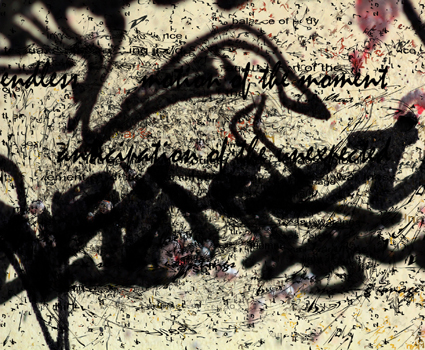
Brigid Burke, seensound
courtesy the artists
Brigid Burke, seensound
seensound: visual/music, Loop Bar
Seensound, curated by Brigid Burke, is an ongoing series exploring visual music, the aesthetic translation of music into colour and light and vice versa. The next event features performances and screenings by Ros Bandt, Warren Burt, David Kim-Bolye, Elaine Thomazi Fritas/Johnathan F.Lee, Roger Alsop, Mark Pedersen and Burke herself.
seensound: visual/music , LOOP back room, Melbourne, 24 Nov; http://seensound.com
the NOW now 2014 Launch
In preparation for the always epic and enjoyable Now Now Festival in January (8-12), there’ll be the annual free program launch party featuring Robbie Avenaim & Martin Ng, Horse MacGyver, M.O.B., Lucas Abela and Pollen Trio. As always, much to enjoy and a little bit of everything for everyone.
Now Now 2014 Launch, The Red Rattler Theatre, 4 Dec; http://thenownow.net/
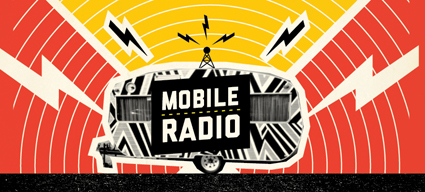
Mobile Radio, Big West Festival
Big West Festival, Footscray
Celebrating community and creativity in Melbourne’s western suburbs, the biennial Big West Festival is about to kick off. There are 65 events, many of them free, promising to be “radical & spectacular.” One of the feature programs is Mobile Radio, headed up by sound art duo Madeleine Flynn and Tim Humphrey, in which the Mobile Radio will land in different locations in the area. People are invited to book a slot on air, which will be webcast and transmitted on 99.9MHz. The team has been conducting workshops with the community for the last month on how to present their ideas, and they’re ready to broadcast!
Big West Festival, Footscray, 22 Nov-1 Dec; http://www.bigwest.com.au/; http://www.mobileradiobigwest.com/
FILM
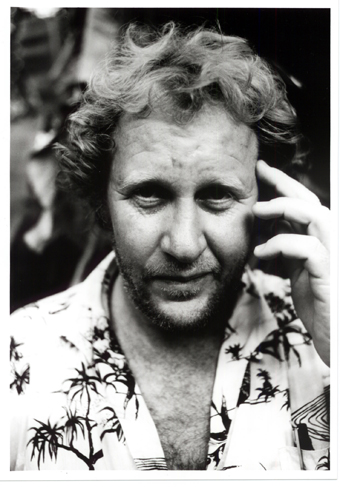
Dennis O’Rourke (1988), during the making of Cannibal Tours, released as free content with permission of Dennis O’Rourke, photo Chris Owen & Camerawork Pty Ltd
Dennis O’Rourke Memorial
In his obituary for documentary filmmaker Dennis O’Rourke in RT116, Dan Edwards wrote “Provocative, emotional and fiercely intelligent, O’Rourke was always worth listening to—and always worth watching. With his death on June 15, Australia lost one of its most incisive and imaginative documentarians.” (http://www.realtimearts.net/article/116/11250) To honour and celebrate O’Rourke’s life and work, Ozdox, the Australian Documentary Forum will be hosting an industry memorial at the Chauvel Cinema, Sydney.
Dennis O’Rourke Memorial, Chauvel Cinema, Paddington, 7 Dec (RSVPs by 6 Dec); http://www.ozdox.org/events/dennis-orourke-memorial/
Fallout, Lawrence Johnston
Sydney audiences will be treated to a special cinema season of Fallout, a new documentary by Lawrence Johnston. The doco goes behind the scenes of the making of the Hollywood film On the Beach, which brought Gregory Peck and Ava Gardner to Australia for the filming. On the Beach, based on the book by Neville Shute, had a sobering anti-nuclear message but writer and film director Stanley Kramer soon began to see issues differently. Check out the trailer here.
Fallout, director Lawrence Johnston, producer Peter Kaufmann, Dendy Newton, from 5 Dec.
Still in the loop
Dance Clan 3, Bangarra Dance Theatre
20 Nov-1 Dec
http://www.bangarra.com.au/
Corroboree, various venues Sydney, 14-24 Nov
http://www.corroboreesydney.com.au/
born in darkness before dawn, Nicole Foreshew
City of Sydney, Place Projections, Australian Museum
19 Nov-20 Jan
http://www.cityartsydney.com.au/cityart/projects/PlaceProjections.asp
string theory: focus on contemporary Australian art, PICA
16 Nov 2013 – 5 Jan 2014
http://www.pica.org.au/view/string+theory/1744/
Karen Casey, Dream Zone, FAC
23 Nov 2013-19 Jan 2014
http://fac.org.au/
The Adventures of Namakili & I Am Man, Brown’s Mart & New Blak Territory
Brown’s Mart; 19-30 Nov
http://brownsmart.com.au/events/new-blak-territory-adventures-namakili-i-am-man
The Changing Standards of Dialogue, Other Projects, Metro Arts
3-30 Nov, Artist talks 20 Nov
http://www.metroarts.com.au/
ANTI–MUSIC: 1979–1983, Pestorius Sweeney House
30 Oct—13 Dec 2013
http://www.davidpestorius.com
Tiny Stadiums, PACT
2-23 Nov
http://www.pact.net.au/2013/10/tiny-stadiums-2013
This is a Door, Pop-Up Playground
Theatreworks and various venues, St Kilda and Melbourne City
Oct 31-1 Dec
http://popupplayground.com.au/this-is-a-door-2013/
Wagnerlicht, Arts Centre Melbourne
15 Nov-14 Dec
http://wagnerlicht.com
La Boite Indie: R & J
La Boite Roundhouse Theatre, Brisbane
13- 30 Nov
http://www.laboite.com.au/cms/page.asp?ID=21
Standing Bird Two, Verge, The Blue Room
13-30 Nov
http://blueroom.org.au/
Trace Recordings UTS Gallery
until 29 November
http://www.art.uts.edu.au/gallery/current/index.html; http://www.tracerecordings.net/
Performa, NY
various venues New York City
1-24 Nov
http://13.performa-arts.org/
My Avant-Garde Is Bigger Than Yours, Kings ARI
1-23 Nov 2013
http://www.kingsartistrun.com.au/
Crash Course, James Berlyn
PICA, 14-30 Nov
http://www.pica.org.au/view/Crash+Course/1745/
[CTRL][P] Objects on Demand, Object Gallery
15 Oct 2013 – 25 Jan 2014
http://www.object.com.au/exhibitions-events/entry/ctrl_p_objects_on_demand/; http://ctrlp.com.au/
Lorraine Heller-Nicholas, Love Story, Videobrasil
Southern Panoramas, 6 Nov-2 Feb
http://site.videobrasil.org.br/festival/arquivo/festival/programa/1589140
Daniele Puppi 432 Hertz, Cinema Rianimato e Dintorni, AEAF
1 Nov-7 Dec
http://www.aeaf.org.au/exhibitions/danielepuppi.html
Simple Forces, Joyce Hinterding
BreenSpace
25 Oct-23 Nov
http://www.breenspace.com/
Reinventing the Wheel: the Readymade Century
MUMA
3 Oct-14 Dec
http://www.monash.edu.au/muma/exhibitions/upcoming/readymade.html
Bogong ELECTRIC
Bogong Village, North East Victoria
1 Nov-1 Dec
http://bogongsound.com.au/
RealTime issue #117 Oct-Nov 2013 pg. web
© RealTime ; for permission to reproduce apply to realtime@realtimearts.net
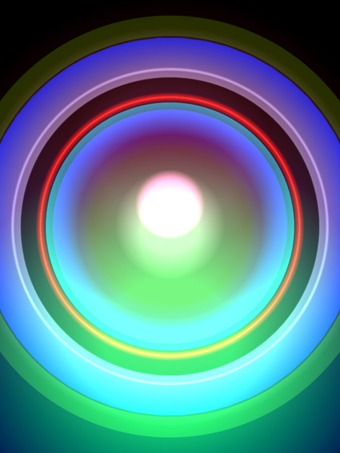
George Khut, Distillery: Waveforming 2012 (detail), developed with assistance from a 2011 Synapse residency
courtesy the artist
George Khut, Distillery: Waveforming 2012 (detail), developed with assistance from a 2011 Synapse residency
2014 Synapse Residencies, ANAT
Applications are now open for the Synapse Residency program for projects in any discipline that involve collaboration between artists and scientists. Residencies are over 16 weeks full-time (or part-time equivalent).
Deadline 7 February 2014; http://www.anat.org.au/2013/11/call-for-applications-2014-synapse-residencies/
ART-Town: call for artists
Melbourne’s Chapel Street precinct is calling for applications for artists to be in-residence, making site-responsive works over the weekends of 29-30 March and 5-6 April 2014. There’s also a prize pool of $4000 for winning artworks.
Applications close March 3; http://www.arttown.com.au/
Hatched, Ensemble Offspring
Ensemble Offspring have just announced their inaugural Hatched program which sees an emerging composer and performer undertake intensive mentorship for 12 months. At the conclusion of the year they will present a program of works developed in association with this celebrated new music group. Applications are invited from artists 30 and under from around Australia.
Deadline 11 Dec, 2013; http://ensembleoffspring.com/ensemble-offspring-academy/
Skip Ahead, YouTube & Screen Australia
You Tube & Screen Australia have come together to offer a unique funding initiative for Australian content producers to create online video content. Up to $100,000 is available for web series projects proposed by artists or groups who already have a YouTube channel with 100,000 subscribers or more. Up to five projects will be funded and successful applicants will also receive a training trip to one of YouTube’s “Spaces” in Tokyo, London or Los Angeles in March/ April 2014.
Deadline 20 Dec, 2013; http://www.screenaustralia.gov.au/getmedia/0aa1c24a-6854-4687-8ece-085cc850aa4a/Guidelines_SkipAhead.pdf
Amplify Your Art, Accessible Arts
A funding initiative of Arts NSW devolved to Accessible Arts, Amplify Your Art offers grants of $5,000-$10,000 to artists with disabilities to undertake mentorship, training and other professional development activities. Also check out RealTime 118 Ennabling Art feature.
Deadline 18 Dec, 2013; http://www.aarts.net.au/amplify/
Still in the loop
Public Art, Heffron Hall, City of Sydney
Tenders due 6 Dec; http://www.cityartsydney.com.au/cityart/news/?p=1871
Exposure Summer Intensive, Tasdance
Applications currently open; http://tasdance.com.au/exposure/; for more info email richard@tasdance.com.au
CJZ/Rock Surfers New Writing Commission
Deadline 2 Dec; http://rocksurfers.org/newwords/
Courthouse Arts Visual Arts Program
EOIs due 15 Nov; http://courthouse.org.au/on-now/searching-for-a-young-curator-for-2014/
Editor, Un Magazine
Applications due 25 November 2013; http://unprojects.org.au/magazine/contribute/
Waterwheel Symposium Call for Participation
Proposals for Symposium due 22 Nov; proposals for Voice of the Future Youth Day, 31 Dec; http://water-wheel.net/
Selected Australia Council Grant Deadlines
(for full list go to http://www.australiacouncil.gov.au/grants
Visual Arts Travel Fund – 25 November 2013
http://www.australiacouncil.gov.au/grants/2013/Visual-Arts-Travel-Fund
Contemporary Music Touring Program – 25 November 2013
http://www.australiacouncil.gov.au/grants/2013/contemporary-music-touring-program-25-november
RealTime issue #117 Oct-Nov 2013 pg. web
© RealTime ; for permission to reproduce apply to realtime@realtimearts.net
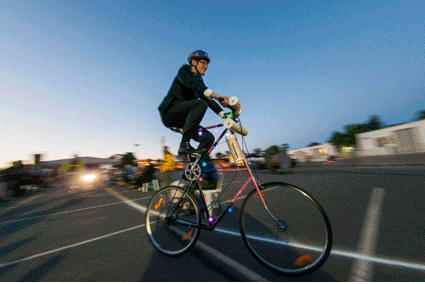
The Canberra Pursuit, Jon Rose and collaborators, Canberra100
photos Martin Ollman
The Canberra Pursuit, Jon Rose and collaborators, Canberra100
As part of Canberra’s Centenary celebrations, Jon Rose has presented the largest version to date of his Pursuit project, modifying over 130 bikes to become musical instruments. Below he offers a personal account of this unique art venture that combines experimental music, sculpture, community creativity, ecological responsibility and, of course, fitness. [Eds]
According to The Australian Bicycle Council, Canberra comes out way on top compared to the national average on most statistics to do with bicycle ownership, work and pleasure use, participation by gender and number of bikes per household. So, from an organisational perspective, Pursuit was a perfect match for a town that has always considered the bike in its planning priorities. As Pursuit was being built at TAMS (basically the transport services depot for Canberra), a new bike lane was under construction right outside the front gate—in an industrial zone (unthinkable in Sydney). The site itself was huge and included a large ‘hangar’ space and car park in our operational zone.
I thought we would be stretched to present 80 musical bikes for Pursuit; we ended up with an astonishing 130 in the event, from the very simple (foot pumps attached to pedal powered whistles), to quite complex machines (a piano tuned to an F major chord and played by two independent ‘hands’ adjusted in range, pitch inversion and rhythm by the position of the handlebars). By chance, the last instrument made for the previous Pursuit (at Mona Foma 2010).) became the model mechanism for a number of instruments in the Canberra Pursuit—light, robust, comparatively easy to assemble, minimal welding and spoke driven—we named it The Tickler. And tickle it did, via a host of different resonating objects from oil drums to metal plates and wooden boxes.
The main instrument makers were Wayne Kotzur, Paul Bryant and me. To this central production team came significant members of The Rat Patrol, the Melba Copeland Chopper program, Jim Sharrock, the outstanding Bell Chamberlain—about 25 makers in total. An attempt to integrate the local Make Hack Void into building a wide-ranging re-cycled electronic junk component for Pursuit went off the boil; the exception was Adam Thomas, who re-cycled an old Atari. Included in The Canberra edition of Pursuit were a few instruments from earlier manifestations of the project, including the original Viocycle with gearing designed by Paul Bryant (first experienced at The Sydney Velodrome in 2004) and Rod Cooper’s excellent ping-pong bass drum (2009).
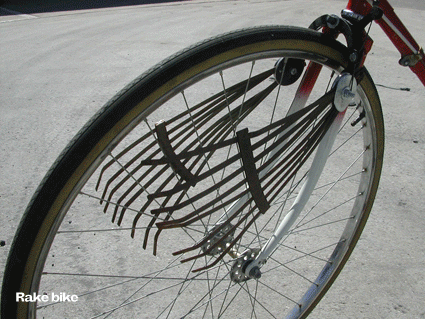
The Canberra Pursuit bikes made by Wayne Kotzur, Paul Bryant and Jon Rose, with extra contributions from Richard Johnson, Bel Chamberlain, Sam King, Harry Vatiliotis
photos Jon Rose
The Canberra Pursuit bikes made by Wayne Kotzur, Paul Bryant and Jon Rose, with extra contributions from Richard Johnson, Bel Chamberlain, Sam King, Harry Vatiliotis
New music species
The musical bikes of Pursuit can be divided up into six classes of homemade instrument making:
1. regular musical instruments played by the cyclic mechanism of a moving bike, eg viola or guitar;
2. artefacts not normally associated with music performance which were sonified by bike action, eg a baking tray, a polystyrene vegetable box, dragged and ‘flapperphoned’ drainage pipes, reversing truck bleepers, forty-gallon drums, a water bottle amplified clicker, a fire extinguisher, typewriters (it was Canberra’s birthday!) or a siren (despite Edgar Varèse, this perfect glissando of an instrument remains exotic in orchestral music);
3. constructed extensions to bike mechanisms that manipulate or interfere with the basic repeating cycle of motion, eg a bike fitted with a tennis racket hitting syncopated and timbrally varied strokes with a golf ball into a plywood net;
4. musical instruments uniquely designed and made to function with a moving bike, eg The Grand Fiddle or the Ping Pong bass drum;
5. sonic phenomena induced by stationary exercise bikes, eg the Plectraphone or the Double Violin (2VC);
6. psychoacoustic disturbances intensified by visual and physical bike action, eg the double hammer bike built by Wayne Kotzur—an existentialist statement if ever there was one.
Unlike digital loops, the repetition of bicycle-powered instruments, although cyclic, are not exact copies of previous sonic events. Every cycle of sound reveals sonic transformation, shifts, sometimes subtle, sometimes radical—the most radical being when the mechanism screws up. The use of re-cycled and unreliable materials creates a natural tension; no one can predict if the instrument will last years, days, or minutes.
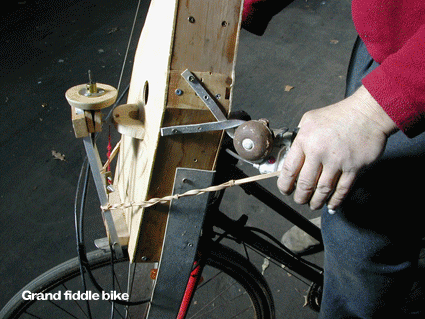
The Canberra Pursuit bikes made by Wayne Kotzur, Paul Bryant and Jon Rose, with extra contributions from Richard Johnson, Bel Chamberlain, Sam King, Harry Vatiliotis
photos Jon Rose
The Canberra Pursuit bikes made by Wayne Kotzur, Paul Bryant and Jon Rose, with extra contributions from Richard Johnson, Bel Chamberlain, Sam King, Harry Vatiliotis
Participatory pedal power
I had originally been encouraged by Dan Watters (the key figure in The Rat Patrol) to believe that several hundred riders would be easily persuaded to take part in Pursuit. In the end, it was hard work finding 50 riders who were keen and engaged in the possibilities of making music through re-cycled bike technology. The gap between serious bike riders, feral cyclists, bike collectors, sculptors, student musicians, casual cyclists and electronic hobbyists remained problematical, despite my efforts to bring the various groups together. Both Dan and I spent much time trying to encourage commitment to Pursuit on a local Canberra level with mixed success. However, I don’t think we could have coped with any more riders on the actual performance night as the last 10 minutes of the spectacle pretty well filled up the track; any more would have constituted a safety hazard.
Talking of which—there were, as predicted, no safety issues despite many bikes having only one brake (the other brake often engaged in musical manipulation such as pitch and rhythm variants) and operating way beyond ‘manufacturer’s specification.’ All bikes and riders returned from the track without incident in both the rehearsal night and the public performance itself. Public Liability insurance was forced on me, but wouldn’t have been worth the paper it was printed on in the event of a claim. It would have been difficult to find a bike in our collection of re-cycled junk without rust, a ding or two or evidence of serious neglect (abundant wildlife was also noted).
The contribution by Jeff Thompson at LEAD was exceptional. He lent us 42 bikes for the event, plus spare tyres, tubes, bells etc. With very few exceptions, all the second-hand bikes were returned in their original condition, the mechanical devices stripped or angle grinded off on the following day after the performance. On the Monday before Pursuit took place, Jeff visited the TAMS site with his team of employees, all of whom were mentally or physically disabled. They were without doubt totally excited by the whole project of which they were a part.
Highlight: one of the guys who struggled to keep up with the rest and who appeared devoid of any expression or speech, pointed at one of the bikes. “You want to ride it?” I asked. No reaction, but I assumed the affirmative and helped him on. Suddenly, he burst out with the broadest possible smile as the sounds started to spin and cascade around the space. This was one of the stationary exercise bikes attached to a previously discarded gas cylinder (the section cut instrument sounded like a sped up gamelan orchestra). That guy’s pure elation was a moment hard to beat.
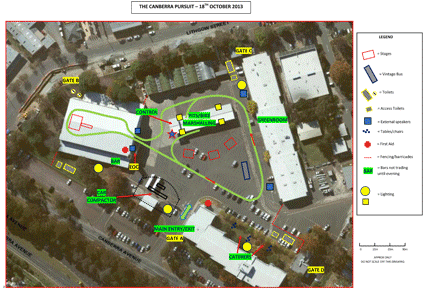
The Canberra Pursuit, route map, Jon Rose and collaborators, Canberra100
photos Martin Ollman
The Canberra Pursuit, route map, Jon Rose and collaborators, Canberra100
Bike & bytes
Combined with the re-cycled and the rusty were two interactive systems. Sam Fergusson wrote and managed the software for the interactive sensor strip that riders cycled over every time they entered ‘The Hangar,’ triggering a selected array of alert sounds, from foghorns to old Apple Macintosh alerts, from car horns and alarm clocks to cockerels. By nature of Pursuit being a community project, I had to consider the possibility that anyone might turn up with a bike on the night and demand to ride; the sensor strip ensured a democratic sonic marker.
Sue Powell (a Paralympic champion cyclist, no less) honoured us by riding her bike (designated the e-bike) fitted with a special box of accelerometers and contact microphones that transmitted bike movements and speed as data to a central computer. This data was then put to use manipulating many aspects of the surround sound audio (which I controlled using my ancient Steim-based software). Video from two live feeds and pre-recorded close up images from over 30 of the musical bikes provided details of how the instruments actually worked. The four riders of The Canberra Bicycle Powered Cinema produced enough DC to power Louise Curham’s appropriate Super 8 film installation, which ran in parallel to the three video screens (two open air, one interior).
They’re racing
The broad structure of The Canberra Pursuit was provided by a time sheet. Every two minutes, on the minute, a new wave of riders hit the track and for three laps proceeded to sound out the space with their specially constructed musical machines (three laps took between 5.20 and 5.50 minutes to complete). Each wave had specific sonic characteristics: for example, a swarm of clicker bikes; a deconstructed drum kit on four bikes (ride cymbal, bass drum, floor tom, tickler snare); Richard Johnson’s trio of reeds and fantastic plumbing bikes; or The Rat’s DJ bike (Master Gravity) where the ruts in the track corresponded to the heavy scratching of a vinyl disc (Queen’s “Bicycle Race”). Some bikes re-constituted themselves for use further into the composition so, the cluster of pedal pumping whistle bikes had their sensitive moving parts removed to render them focused for the bicycle bell episode just prior to the final act.
Since the early 1980s I have been intrigued by the notion that music could be measured as a distance-based expression as much as time based one: not how long is a piece of music, but how far? The wheeling triple necked violin made in 1984 was an attempt at realising this functionality. (http://www.jonroseweb.com/d_picts_wheeling_violin.html)
The track for The Canberra Pursuit came in at 463 meters long, so each performer/bicycle/instrument travelled 1,389 meters in their specific section and since there were 130 machines, we ended up with 180,570 meters of individually defined music plus an unquantifiable distance sonified in the final 10-minute all-in bedlam. The performance lasted one hour. Well, in hindsight there were anomalies, as the piano bike only lasted two laps, the World of Wheels tandem vanished from the pits and at least two of the musical bikes never made the starting grid (these were the feedback handlebar bike and the amplified bowing machine that I had left charging in the storeroom and had completely forgotten about).
On discovery that Bunnings had just taken delivery of their Christmas stock of festive lights and were flogging them at knockdown prices, Dan Watters cleared the store and the visual results as day turned into night around the Pursuit Track were quite stunning for a budget-light show—Catherine Wheels spinning like crazy—and in colour. I hadn’t expected it, but many bikes were turned out in feral finery with feathers, horseshoes, beerbottle tops (the most resplendent and abundant drag Lagerphone ever) and spray cans au-go-go.
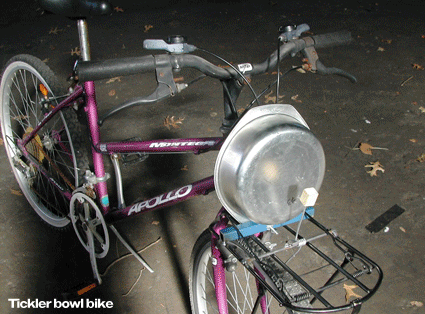
The Canberra Pursuit bikes made by Wayne Kotzur, Paul Bryant and Jon Rose, with extra contributions from Richard Johnson, Bel Chamberlain, Sam King, Harry Vatiliotis
photos Jon Rose
The Canberra Pursuit bikes made by Wayne Kotzur, Paul Bryant and Jon Rose, with extra contributions from Richard Johnson, Bel Chamberlain, Sam King, Harry Vatiliotis
Celebratory new music
It was the legendary Sydney violin maker Harry Vatiliotis who pointed out to me that The Pursuit Project had much in common with the ancient practice of Charivari—the use of noise (rough music or people’s music) for celebration, some sorts of community censure and demonstrations to achieve social, cultural or political change. (A worldwide example of Charivari survives today with the practice of tying tin cans to the back of a car carrying newlyweds surrounded by well wishers energetically hooting their car horns). Pursuit can indeed be considered an example of Charivari, in the sense of both celebration (of Canberra’s birthday) and pointer for ecological revolution, a music practice that demands change in our species behaviour by creating music with trash that celebrates, rather than denies, a sense of place (most music performed in Australia ignores its geographical, cultural and historical context).
By definition, a new musical instrument will tend to produce new music and Pursuit was structured so that, even with fifty acoustic bikes on the track at one time, combined with two systems of amplified interactive sound, each individual bike could be heard as it passed each individual set of ears of an audience member. More often, much smaller constellations could be heard in close focus, in middle distance and amplified through the surround sound up to 100 meters away, all sounds moving at various speeds continuously (except for one stationary ensemble of exercise bikes). Then there were the close up and personal mixes for each cyclist and musical bike, sounds overtaking other sounds along the track, sounds colliding in space.
How much of this became evident to those taking part is a debatable point. Time constraints limited the options of getting to know each musical bike—these instruments were not automatons, they required physical reciprocal operational knowledge. Despite detailed instructions attached to each bike, the musical options of many bikes were likely underutilized, the overall sound world disorientating and fast moving for some, a joyful adrenalin fix for others. Of the 50+ makers and riders involved with Pursuit, only four to my knowledge were bona fide musicians. The experience of Pursuit took place outside the traditional actions and responses of a musician-based performance. I wonder if I’d been able to pay members of a symphony orchestra to take part, whether the musicality would have been better or worse? I’ll leave that question in the air.
Highs & lows & in betweens
High Point: operating two huge surround sound sonic spaces (a ‘Hangar’ and a car park) that were both audible simultaneously. As day turned to night, the other features of mobile sound such as Doppler, phasing, delays and modulations were also audible in the windless Canberra spring evening for those who wanted to hear. Others were there for the social hang (fine by me); when did you last hear members of an audience screaming with delight throughout a new music event?
Low Point: my inability to coax music students from the ANU to get involved with the project. What is it with this generation, the lack of curiosity?
The Point that never ceases to amaze me: how the management of TAMS never stepped up to the mark with a proper professionally painted lined track for the 100th Anniversary and celebration of their town, embarrassing their employees (the guys who do the lines on the roads) and anyone who owes Canberra for a very comfortable living. As a member of the Centennial team remarked, I’ll go to my last days still harbouring that special place of bewilderment in my brain.
Favourite Instrument du Jour: The Ukulele Bike
Pursuit exhibited a large number of professional skills, homemade know how, hands-on knowledge and instrument making techniques and concepts exploring the notion of what constitutes a musical instrument. I don’t know of any other occasion in the musical history of Australia (or anywhere else for that matter) where so many instrumental experiments have been improvised into existence in such a short space of time and returned to their various states of entropy and atrophy immediately post performance—a short lived trajectory like the nature of musical performance itself.
Thanks
Wayne Kotzur and Paul Bryant were key to the success of this project—extra hours, trailer trips, you name it. Special Thanks to Justin Watson, Julian Hobba, Dan Watters (the key link between the world of cycling and the Centenary) for their tolerance and commitment; and to Robyn Archer for taking a risk by providing the original invitation.
Canberra 100: Pursuit 3, concept, composer & director Jon Rose, main instrument makers Paul Bryant & Wayne Kotzur, community engagement Dan Watters; TAMS Depot, Fishwyk, Canberra, 18 Oct; http://www.jonroseweb.com/f_projects_pursuit.html
See also our Archive Highlight compiling our coverage of Jon Rose in RealTime over the years.
Canberra 100: Pursuit 3, concept, composer & director Jon Rose, main instrument makers Paul Bryant & Wayne Kotzur, community engagement Dan Watters; TAMS Depot, Fishwyk, Canberra, 18 Oct; http://www.jonroseweb.com/f_projects_pursuit.html
Links
http://www.youtube.com/watch?v=xpJubsaURps
www.youtube.com/watch?v=0KiGCwJ5b3k
http://www.youtube.com/watch?v=jIwQpzEzIqI
RealTime issue #117 Oct-Nov 2013 pg. web
© Jon Rose; for permission to reproduce apply to realtime@realtimearts.net
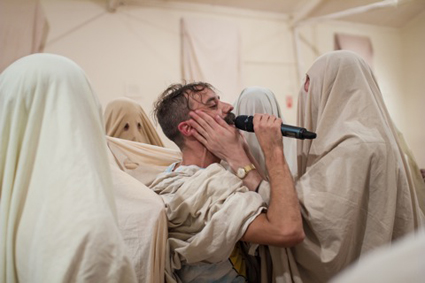
Luke George and collaborators, Not About Face
photo Nick Roux
Luke George and collaborators, Not About Face
I have moved in a flock—a flock of ghosts—led round an empty room by a mystical maverick. This is one memory, at least, that I can take away from Not About Face, a work to be felt and experienced rather than merely seen.
Luke George has us enter the seatless studio space draped in sheets with cut-out eyeholes, the first in a string of whimsical experiments to tweak his audience’s consciousness. Anonymity strikes as we roam, awaiting the show. “What’s under your sheet?” we wonder, our interior worlds reified, yet not revealed. (It’s a bit like a masquerade party, but we are homogenous as Halloween ghosts.) So the stuff of the spirit is raised in a literally material way—a droll device, and one that arouses doubts. What distinguishes us as we roam in these veils? How do we now ‘see’ the other? The self? And how does this change the way we inhabit the moment, our movement, and space?
You could say we’ve been given new and identical ‘bodies,’ and an involuntary flock or herd feeling is born. We shuffle about with tunnel vision and fuss with our eye holes, our sheets flow around our limbs as we move and our motions are further swayed when Luke George takes the floor.
He appears in our midst as a fellow ghost, with a hiss and a stifled shriek, then unveils himself, revealing his blindfolded face (and so, our performer is vulnerable too). “Follow me, follow me,” he urges, and we glide along, drawing back when he whirls like a dervish or strikes out a path to the wall. But what stirs the flock further still is his fitful soliloquy on the spirit and what it might mean. When the blindfold is lifted he delivers synaesthesiac speculations on the colour of our souls, and then the sounds of those colours, until he unites us all in a brief, fleeting chorus on the theme.
Such New Age allusions are rampant throughout the work, and there’s much to be said for George’s wry presentation of “aura-reading and energy-conversion” among other phenomena. He seems to have seen that there’s no escaping the kitsch, the whiff of occultism, the cultural trappings that so taint our grasp of the mystical, so he takes the whole swag and exploits and transforms it into a genre in itself. But while his treatment is exuberant and camp, he does not surrender to satire. True, he writhes and shrieks and speaks in otherworldly tongues at times, but with an air of amused demonstration and daring more than anything else.
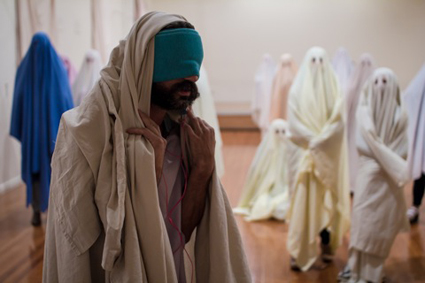
Luke George and collaborators, Not About Face
photo Nick Roux
Luke George and collaborators, Not About Face
Overall, the work is woven by George’s sincere and lucid intent—he speaks as himself between ‘acts’—to draw our embodied presence into the moment. Is this the business of live art? Of mysticism? Of both, no doubt. But it also looks quite naturally to be the business of dance. George almost precludes remote viewing (the long-distance firing of mirror neurons at best), instead drawing us into collective engagement and (by way of experimental enactment) an inkling, yes, of the mystical.
At the highpoint of the work he invites us with feverish urgency to press his body with our hands and release into an afterglow of sensations. Then we all sink to the floor and get cosy. This is the confessional heart of the show, and the moment when we consider what reservations to suspend. “How close can we get?” George offers to swap clothes with someone in the room and “dance their dance”—an offer that I, glancing down at my lovely green dress and black boots beneath my sheet, can hardly decline.
Does he dance my dance? I would say that he does, surprisingly. And he also looks fetching in the dress, allowing the power of costume to come into play. Here again, the ‘material’ acts as an opening for the intangible—call it the spirit if you will, although style figures in this instance as well. But regardless of how we define this stuff, what Luke George aims to show is his (and therefore our) capacity to tune into one another and to connect.
So it’s only fitting that, after all this bonding, he unveils the group—with a camp rendition of a magical spell—and ends with a coda of sorts, by dancing a dance that looks authentically all his own. Taut but skittish, erratic but graceful, strutting and posing to electronic music in a wrestling singlet, it is a flamboyant display to end an absorbing work.
Not About Face, Luke George with collaborators Hillary Clark, Nick Roux, Benjamin Cisterne, Martyn Coutts, performer Luke George, Dancehouse, Melbourne, 9-13 Oct
This article first appeared as part of RT’s online e-dition 20 November, 2013
RealTime issue #118 Dec-Jan 2013 pg. 30
© Jessica Sabatini; for permission to reproduce apply to realtime@realtimearts.net
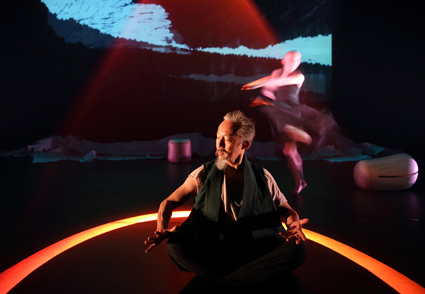
Xiao Xiong Zhang, Not According to Plan, Leigh Warren & Dancers, OzAsia Festival
photo Tony Lewis
Xiao Xiong Zhang, Not According to Plan, Leigh Warren & Dancers, OzAsia Festival
This latest work from Leigh Warren & Dancers featured in the OzAsia Festival is visually stunning. And yet that expression does not describe my sensual response to what unfolded on stage. It is not ‘spectacular’ in the sense of establishing distance between spectator and event. The images, colours, shapes, textures, movement, music and light captivated me like the perfume of jasmine or the movement of silk or the sound of rain or the intense colour of tropical vegetation. It is a deeply satisfying sensual work.
The work emerged from collaborations between Adelaide-based choreographer Leigh Warren and lighting designer Geoff Cobham with Cambodian born dance artist Xiao-Xiong Zhang (the “subject of the work”), Malaysian-Australian furniture maker Khai Liew, Australian-Vietnamese fashion designer Alistair Trung and Malaysian writer and musician Jerome Kugan. The production unfolds as a set of evocative images that move and transform. We experience this unfolding as waves of sound, colour, light and movement washing across the stage. These images and waves are responses to the life of Xiao-Xiong who is both observer and participant in the unfolding dance. Other elements include: projections of ink wash drawings and calligraphy by Helen Fuller on a rice paper screen; rich, swelling music drawn from a broad palette of sound; Xiao-Xiong’s recorded voice; billowing and fitted intensely coloured costumes (burgundy, black, green) that reference clothing from various Asian countries; an exquisite landscape of finely turned, wooden furniture initially buried beneath a floor ‘cloth’ textured like handmade paper; and boldly coloured light (electric blue and salmon pink among others) that defines the space, the furniture and the dancers.
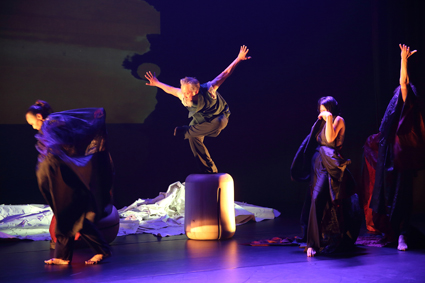
Xiao Xiong Zhang, Not According to Plan, Leigh Warren & Dancers, OzAsia Festival
photo Tony Lewis
Xiao Xiong Zhang, Not According to Plan, Leigh Warren & Dancers, OzAsia Festival
For so many years now Leigh Warren has trained dancer after dancer. His training and choreography ask the dancer to move seamlessly like water spilling in all spatial dimensions and in relation to each other’s bodies, with legs and spine as articulate as arms. Here the dancing is organised into duets, solos, a trio and final quartet in relation to the figure of Xiao-Xiong, but it converses with costume, music, light, set, projection and image rather than speaking solely according to a physical logic discrete from all other elements. For me, Warren’s choreography is always located between meaning and pure physical eloquence. The four dancers’ gestures, their interactions with Xiao-Xiong and the recorded spoken stories hint at a life lived across a number of countries and the challenges, resolve and pleasures of that life. Meaning lurks but does not dominate and must be felt through the sensuous appreciation of the work in its entirety.
OzAsia Festival, Leigh Warren & Dancers, Not According To Plan, choreographer Leigh Warren, performers Rebecca Jones, Aidan Munn, Yuan-Li Wang, Chien-Wei Wu, Xiao-Xiong Zhang; Space Theatre, Adelaide Festival Centre, 20-21 Sept
For background on Anne Thompson, see our contributor profile feature.
This article first appeared as part of RT’s online e-dition 20 November, 2013
RealTime issue #118 Dec-Jan 2013 pg. 31
© Anne Thompson; for permission to reproduce apply to realtime@realtimearts.net
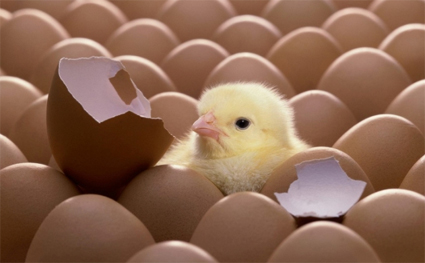
Ensemble Offspring, Hatched
Hatched, Ensemble Offspring
Ensemble Offspring have just announced their inaugural Hatched program which sees an emerging composer and performer undertake intensive mentorship for 12 months. At the conclusion of the year they will present a program of works developed in association with this celebrated new music group. Applications are invited from artists 30 and under from around Australia.
Deadline 11 Dec, 2013; http://ensembleoffspring.com/ensemble-offspring-academy/
Skip Ahead, YouTube & Screen Australia
You Tube & Screen Australia have come together to offer a unique funding initiative for Australian content producers to create online video content. Up to $100,000 is available for web series projects proposed by artists or groups who already have a YouTube channel with 100,000 subscribers or more. Up to five projects will be funded and successful applicants will also receive a training trip to one of YouTube’s “Spaces” in Tokyo, London or Los Angeles in March/ April 2014.
Deadline 20 Dec, 2013; http://www.screenaustralia.gov.au/getmedia/0aa1c24a-6854-4687-8ece-085cc850aa4a/Guidelines_SkipAhead.pdf
Amplify Your Art, Accessible Arts
A funding initiative of Arts NSW devolved to Accessible Arts, Amplify Your Art offers grants of $5,000-$10,000 to artists with disabilities to undertake mentorship, training and other professional development activities.
Deadline 18 Dec, 2013; http://www.aarts.net.au/amplify/
Still in the loop
Public Art, Heffron Hall, City of Sydney
Tenders due 6 Dec; http://www.cityartsydney.com.au/cityart/news/?p=1871
Exposure Summer Intensive, Tasdance
Applications currently open; http://tasdance.com.au/exposure/; for more info email richard@tasdance.com.au
CJZ/Rock Surfers New Writing Commission
Deadline 2 Dec; http://rocksurfers.org/newwords/
Courthouse Arts Visual Arts Program
EOIs due 15 Nov; http://courthouse.org.au/on-now/searching-for-a-young-curator-for-2014/
Editor, Un Magazine
Applications due 25 November 2013; http://unprojects.org.au/magazine/contribute/
Waterwheel Symposium Call for Participation
Proposals for Symposium due 22 Nov; proposals for Voice of the Future Youth Day, 31 Dec; http://water-wheel.net/
Selected Australia Council Grant Deadlines
(for full list go to http://www.australiacouncil.gov.au/grants
Music: Presentation and Promotion – 18 November 2013
http://www.australiacouncil.gov.au/grants/2013/music-presentation-and-promotion-18-november
Music: New Work – Writing and Recording – 18 November 2013
http://www.australiacouncil.gov.au/grants/2013/music-new-work-writing-and-recording-18-november
Aboriginal and Torres Strait Islander: Skills and Arts Development –
19 November 2013
http://www.australiacouncil.gov.au/grants/2013/aboriginal-and-torres-strait-islander-arts-skills-and-arts-development-19-november
Aboriginal and Torres Strait Islander: Presentation and Promotion-
19 November 2013
http://www.australiacouncil.gov.au/grants/2013/aboriginal-and-torres-strait-islander-arts-presentation-and-promotion-1-april
Aboriginal and Torres Strait Islander: The Dreaming Award –
19 November 2013
http://www.australiacouncil.gov.au/grants/2013/dreaming-award
Aboriginal and Torres Strait Islander: Fellowships –
19 November 2013
http://www.australiacouncil.gov.au/grants/2013/aboriginal-and-torres-strait-islander-arts-fellowships
Aboriginal and Torres Strait Islander: The Red Ochre Award –
19 November 2013
http://www.australiacouncil.gov.au/grants/2013/red-ochre-award
Aboriginal and Torres Strait Islander: New Work –
19 November 2013
http://www.australiacouncil.gov.au/grants/2013/aboriginal-and-torres-strait-islander-arts-new-work-19-november
Visual Arts Travel Fund – 25 November 2013
http://www.australiacouncil.gov.au/grants/2013/Visual-Arts-Travel-Fund
Contemporary Music Touring Program – 25 November 2013
http://www.australiacouncil.gov.au/grants/2013/contemporary-music-touring-program-25-november
RealTime issue #117 Oct-Nov 2013 pg. web
© RealTime ; for permission to reproduce apply to realtime@realtimearts.net
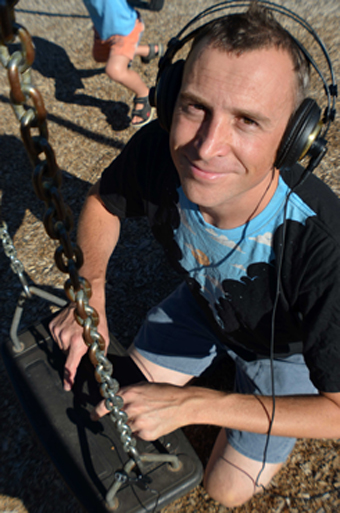
Jason Richardson
photo Jo Roberts
Jason Richardson
To honour the centenary of Leeton, musician and composer Jason Richardson (aka Bassling) decided a sonic celebration was in order. Fitting the swings, roundabouts and slippery dips of all the local playgrounds with microphones he made recordings that he then arranged into an EP of ambient dance music. He also captured video of the “instruments” in action and has created a suite of audiovisual pieces which have since been exhibited by the Albury Regional Art Gallery and screened outdoors around the local area.
Originally from Canberra, Richardson moved to the Wagga region around 13 years ago and is now based in Leeton. He’d played bass in bands that were more on the rock and roll spectrum, but as home studios became more affordable and digital tools began to dominate he made the transition to electronic music. While this shift to a more self-contained music-making was reasonably compatible with the move to a regional area it also meant that his network became smaller, so he turned to the virtual world for inspiration, connection and distribution.
Virtual mixes
Richardson credits the ubiquity of music on the internet as a significant factor in his move towards more experimental realms of music production, providing him with what he describes (via an email interview) as “the history of recorded music at my fingertips…Levi-Strauss’ notion of bricolage has been a key influence. It underpins my interest in remixing, the creative constraint that you use whatever materials are available. I was introduced to remixing through the forum attached to the Ninja Tune website. That community, a decade or so ago, organised remix competitions and I learned a lot from listening to how different producers approached the collection of audio samples taken from a song.” For example Richardson was a significant contributor to the Oceandrift project by the 64 Bars Music Collective, a chain in which one musician posted a track that was remixed by a second artist. The third artist remixed the second contribution and so on, like a musical Chinese Whispers. (Listen to Oceandrift here)
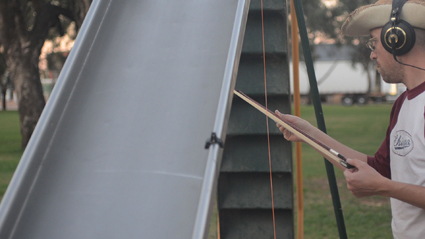
Jason Richardson bowing the slide at Waipukurau Park
courtesy the artist
Jason Richardson bowing the slide at Waipukurau Park
Real vibrations
Back in the real world, a major influence was the Wagga Space Program which ran the Unsound Festivals in the early to mid-2000s and consolidated Richardson’s interest in field recordings (see RT64; RT76). “The Space Program had a cool philosophy that being based in regional Australia was a key part of their sound. That made a lot of sense to me when I started remixing field recordings. I was fortunate to work with Alan Lamb [as part of Unsound 2006]. His large-scale Aeolian Harp [which] he calls ‘the wires’ changed the way I listen to sound.
“Lamb also introduced me to piezo contact microphones, which I used to record playgrounds in Leeton. You capture the vibrations directly with these, rather than the vibrations in air captured [by] a microphone’s diaphragm. It’s quite cool to think you’re hearing how something feels. They also can transform a wide variety of objects into instruments. Like the fence near the playground at the end of my street that makes an evil double bass sound when there’s a strong westerly.”
It was the discovery of sounds like this that saw Richardson embarking on the Playground project. “There were a number of ideas it crystallised, like the founding of Leeton which was around the time of Luigi Russolo’s noise manifesto and, because a centenary is a young age for a town, playgrounds seemed appropriate…When I started recording playgrounds the project snowballed. My internet friends told me they couldn’t see where the sounds had originated. So I started collecting video as well as audio.
“When Albury accepted the three-screen adaptation of Ramponi Park [as part of their] urban art program this year, I decided to organise local screenings of the playgrounds [in Leeton] for the conclusion of the centenary. I ran workshops too, collaborating with kids and a local musician who improvised on a 100-year old pipe organ opposite Mountford Park.”
Ramponi Park, exhibited as a three screen installation as part of Albury Regional Art Gallery’s urban art program
Fruity loops
Art Misadventures #3 is another recent project Richardson participated in, curated by Sarah McEwan for Leeton’s Roxy Theatre Art Space. Six local artists were handed a mystery box and had to come up with an artwork based on its contents in just four days. In Richardson’s box were three Red Delicious apples. Of course his first instinct was to stick a microphone on it and record the secret sounds of the fruit and then remix it. Also inspired by graphic novels, he complemented the sound piece with a comic based on a story from “One Thousand and One Nights” featuring three apples.
The project appealed to Richardson because his remixing practice seems to thrive on working within fixed limits and materials. On his blog he says, “When we were brought together for this exhibition I waited a while before taking a numbered seat, taking one that was left next to my partner. When we were encouraged to select the package holding our inspiration, I waited until others had chosen theirs and I think this strategy served me well. Brian Eno says the first part of any project is scoping the constraints, establishing the parameters as much as the resources available.” (Hear the Apple Remix here)
Think local, go global
While there might be constraints on the size of a local audience in the real world, thanks to free internet tools such as Soundcloud, YouTube and blogging sites, Richardson has been very proactive in seeking national and international ways to be heard. I suggested that he is very good at documenting his work and he responded, “What you call documentation is expression for me. I don’t capture my work to acquit a grant, I do it to interact with an online community because it’s a bigger and more responsive audience.”
Richardson’s next two projects illustrate this balance between local/global, real world/virtual output. For Re-imagining the Murrumbidgee, an exhibition in Leeton produced by Western Riverina Arts and the Murrumbidgee Catchment Management Authority he will create a soundtrack of field recordings of the river composed to “create a sense of the ‘big waters’ and how far they travel through agricultural exports.” Then for his international community he’s instigated another remix chain, as a follow up to the Oceandrift project, keen to garner global responses.
Richardson willingly admits there are advantages to working in the country. “One key benefit of working in a regional context is opportunity. People talk about the lack of things, but it can be a good. My ability to produce work is greatly assisted by not having to negotiate a city each day. It frees [up] a lot of time, reduces stress and my thoughts aren’t interrupted as often by marketing too.”
Most importantly it’s the environment itself that feeds Jason Richardson’s ways of working and listening. “Alan Lamb’s work can only really exist in a regional context. The interplay between the surrounding sounds like birdsong and his wires really captivated me…I was a musician before I moved to regional NSW, but being here has opened my ears to the landscape.”
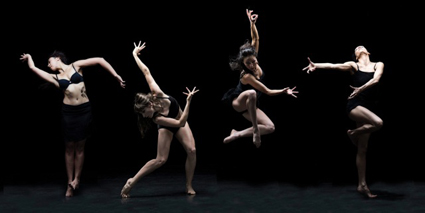
Jasmin Sheppard, Yolande Brown, Tara Gower, Deborah Brown
photo Greg Barrett
Jasmin Sheppard, Yolande Brown, Tara Gower, Deborah Brown
This week we offer just a few of the highlights from a host of Aboriginal and Torres Strait Islander arts activities across the country, ranging from Sydney, to Perth, to Darwin. Plus there are exhibitions from new and old collectives in Brisbane, performance takes to the streets in Erskineville and we get the lowdown on live art in the UK.
Dance Clan 3, Bangarra Dance Theatre
As part of the inaugural Corroboree festival, which sees Aboriginal and Torres Strait Islander arts activities blossoming all around Sydney’s iconic harbour, Bangarra Dance Theatre is presenting Dance Clan 3. Artistic director Stephen Page has invited four of the company’s senior female dancers to choreograph works for the 14-strong troupe. Deborah Brown, Yolanda Brown, Tara Gower and Jasmin Sheppard draw on ancient storylines to create a diverse evening of dance at Bangarra’s home studio at Pier 4. Watch out for the review in RT119.
Dance Clan 3, Bangarra Dance Theatre, 20 Nov-1 Dec; http://www.bangarra.com.au/; Corroboree, various venues Sydney, 14-24 Nov; http://www.corroboreesydney.com.au/
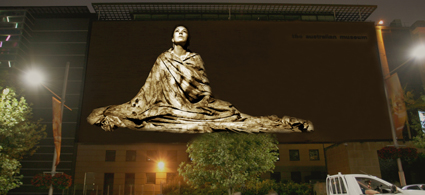
Place Projections, born in darkness before dawn, artist impression by Nicole Foreshew
courtesy the artist
Place Projections, born in darkness before dawn, artist impression by Nicole Foreshew
born in darkness before dawn, Nicole Foreshew
Also as part of the Corroboree festival, the Australian Museum will host a large-scale projection by Nicole Foreshew, presented by the City of Sydney as part of their ongoing Eora Journey project. Born in darkness before dawn is a 20-metre video projection of Aboriginal women draped in a large bolt of cloth, dyed and decorated by Forshew. She writes, “The body is used to perform the absence of place and the cloth is used to explore the language of movement and illumination. Dyed cloth from bark and leaves, found in gutters, water drains and the bottom of trees infuse design elements referencing the growth and structure of plant organisms and remains” (artist statement, website).
City of Sydney, Place Projections: born in darkness before dawn, Nicole Foreshew, Australian Museum, 19 Nov-20 Jan; http://www.cityartsydney.com.au/cityart/projects/PlaceProjections.asp
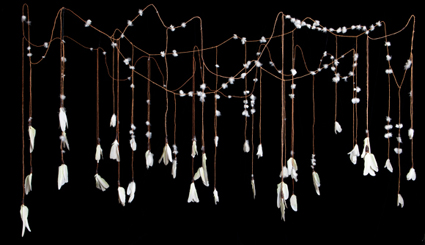
Frances Djulibing, Yukuwa (Feather string yam vine), 2013. Banyan tree bark, cockatoo feathers, beeswax. Museum of Contemporary Art, purchased 2013. Image courtesy and © the artist
photo Alex Davies
Frances Djulibing, Yukuwa (Feather string yam vine), 2013. Banyan tree bark, cockatoo feathers, beeswax. Museum of Contemporary Art, purchased 2013. Image courtesy and © the artist
string theory: focus on contemporary Australian art, PICA
Another activity focused on Indigenous textiles is the MCA touring exhibition titled string theory, currently showing at Perth’s PICA. Curated by Glenn Barkley, the show brings together works from leading Indigenous artists with a focus on “fibre and art in a contemporary context” (website). It includes craft-based practices as well as sculpture, painting, photography and video works. Exhibiting artists and collectives include Tony Albert, Frances Djulibing Boolarng, Lipaki Marlaypa, Nangamai Aboriginal Art & Culture Studio, Noongar Doll Makers, Yarrenyty Arltere Artists, Tasmanian Shell Necklace Makers, Tjanpi Desert Weavers, and Yirrkala Printmakers.
string theory: Focus on contemporary Australian art, PICA, 16 Nov 2013 – 5 Jan 2014; http://www.pica.org.au/view/string+theory/1744/
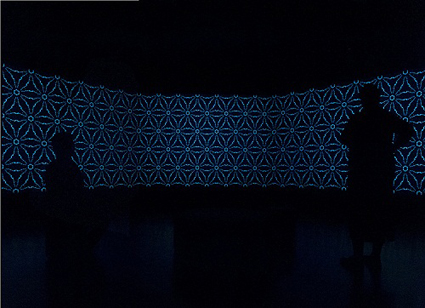
Karen Casey, Dream Zone, 2012, Generative video installation, National New Media Art Award, Queensland Art Gallery/Gallery of Modern Art, Brisbane. 2012
photo Ben Wickes
Karen Casey, Dream Zone, 2012, Generative video installation, National New Media Art Award, Queensland Art Gallery/Gallery of Modern Art, Brisbane. 2012
Karen Casey, Dream Zone, FAC
RT reviewer Laetitia Wilson described Karen Casey’s Mediation Wall, exhibited as part of the 2012 John Curtin Gallery exhibition The World Is Everything That Is The Case, as a “mesmerising piece… a magnificent wash of colour and pattern” (RT110). WA viewers have a chance to see another of Casey’s works, Dream Zone (2012), at Fremantle Arts Centre. Part of her Global Mind Project, Dream Zone uses the artist’s brainwave data to create intricate pulsing patterns that we are told are “reminiscent of various forms of sacred art and intended to invite contemplation and draw the viewer into a deeply meditative state” (website). You’ll be able to read about this work in RT119.
Karen Casey: Dream Zone, Fremantle Arts Centre, 23 Nov 2013-19 Jan 2014; http://fac.org.au/
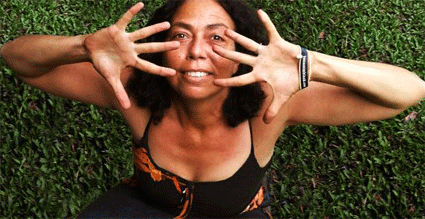
Lynette Hubbard, The Adventures of Namakili; Darren Edwards, I AM MAN
courtesy the artists
Lynette Hubbard, The Adventures of Namakili; Darren Edwards, I AM MAN
The Adventures of Namakili & I Am Man, Brown’s Mart & New Blak Territory
Last week we featured an article from one of our new Darwin-based writers, Nicola Fearn, reviewing the recent Brown’s Mart production, Forced Legacy—The Story of Alyngdabu, by Kathy and Alli Mills with Damien A Pree (read review here). Keeping up the output of new works by Indigenous theatre makers, Brown’s Mart is about to present a double bill. The Adventures of Namakili is created and performed by Lynette Hubbard, “explor[ing] the intricacies of life between two cultures” (website) using a mix of English, Creole and the Wambaya and Warrumungu languages. Accompanying this, I Am Man, created and directed by Ben Graetz, is the inaugural production of the group New Black Territory, presenting an all male cast in a physical theatre work around ideas of “identity, masculinity, sexuality, loneliness, death and love” (website).
Brown’s Mart & New Blak Territory, The Adventures Of Namakili & I Am Man, Brown’s Mart; 19-30 Nov; http://brownsmart.com.au/events/new-blak-territory-adventures-namakili-i-am-man
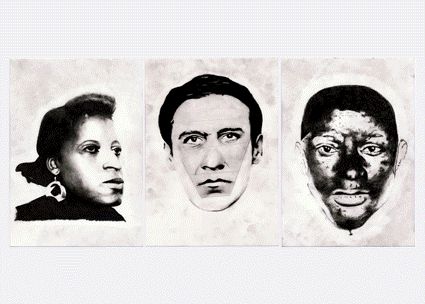
Other Projects, The Changing Standards of Dialogue: Conspicuous Contrasts (detail), 2013; Effigies (2012-2013) detail
The Changing Standards of Dialogue, Other Projects, Metro Arts
Other Projects is Marcel Daniels and Daniel Herberg who have been artists-in-residence at Metro Arts across 2013. The Changing Standards of Dialogue is an exhibition presenting results of their investigations into otherness and “the complexities, paradoxes and grey areas inherent in cross-cultural discourses” (website). The final installation will be an immersive environment incorporating sculptural and image-based works.
The Changing Standards of Dialogue, Other Projects, Metro Arts, Brisbane, 13-30 Nov, Artist talks 20 Nov; http://www.metroarts.com.au/
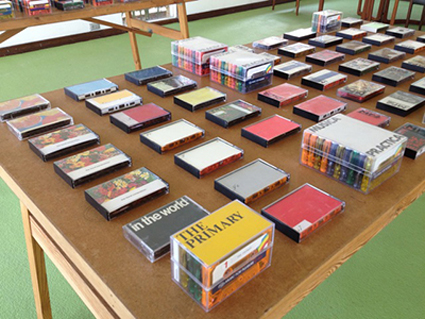
ANTI–MUSIC: 1979–1983, Pestorius Sweeney House
courtesy the artists
ANTI–MUSIC: 1979–1983, Pestorius Sweeney House
ANTI–MUSIC: 1979–1983, Pestorius Sweeney House
ANTI-MUSIC was founded in 1979 by John Nixon (better known as a painter) as a collective enterprise bringing together a range of experimental, post-punk, pop and rock music activities by artists based in Melbourne and Brisbane (where Nixon was director of the Institute of Modern Art 1980-81). ANTI-MUSIC presented the majority of its works on DIY cassettes, while also publishing a journal, Pneumatic Drill. Brisbane curator David Pestorius has been a guardian of much of the archive, producing a number of retrospectives on the group and the era. The archive is currently on display once again in Brisbane until December.
ANTI–MUSIC: 1979–1983, Pestorius Sweeney House, Brisbane; 30 Oct—13 Dec 2013; http://www.davidpestorius.com
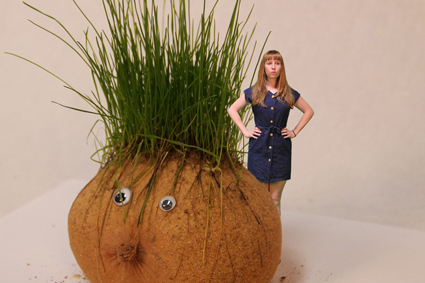
Kenzie Larson, Friend Ship, Tiny Stadiums
courtesy the artist
Kenzie Larson, Friend Ship, Tiny Stadiums
Tiny Stadiums, PACT
Tiny Stadiums is now in its sixth iteration, the second curated by the collective Groundwork. Running in the theatre for the duration of the festival is a double bill comprising Kenzie Larson’s Friend Ship, a multimedia spectacular presenting Larsen’s “groundbreaking research” into how to make friends, and Nick Coyle’s Blue Wizard in which he plays an intergalactic gay wizard trying to find the right magic that will send him home. There’ll also be two live art Saturdays (16 & 23 Nov) in and around the village of Erskineville with performances, installations and interactive experiences by artists including Natalie Abbott, Ella Barclay, Hossein Ghaemi, Bennett Miller and Imogen Semmler. And no festival is complete without art chat in the form of Tiny Talks and Tiny Forums.
Tiny Stadiums, PACT Centre for Emerging Artists; 12-23 Nov; http://www.pact.net.au/2013/10/tiny-stadiums-2013
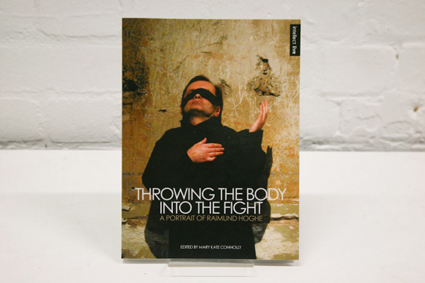
Throwing the Body into the Fight, A Portrait of Raimond Hoghe, a Live Art Development Agency publication
Live Art Development Agency, UK
Looking for Live Art goings on in the UK and Europe? Check out the Live Art Development Agency (LADA) and sign up to their newsletter. Established in 1999 by Lois Keidan and Catherine Ugwu in response to new forms of performance practice developing at the time, the main focus of the organisation has been on developing resources, publications and advocating for the sector via strategic partnerships and presentations. This year alone they’ve been involved in the production of 14 books and DVDs including the Live Art Almanac, a collection of “found” writing about performance; Performance Matters, a 40 DVD box set created in collaboration with the British Library documenting the Performing Idea and Trashing Performance events; Tim Etchells’ latest writing, While You Are With Us Here Tonight, reflecting on his solo work and collaborations with Forced Entertainment; and Throwing the Body into the Fight, a collection of texts on the work of Raimond Hoghe drawn together by Mary Kate Connolly.
http://www.thisisliveart.co.uk/
Still in the loop
This is a Door, Pop-Up Playground
Theatreworks and various venues, St Kilda and Melbourne City
Oct 31-1 Dec
http://popupplayground.com.au/this-is-a-door-2013/
Wagnerlicht, Arts Centre Melbourne
15 Nov-14 Dec
http://wagnerlicht.com
La Boite Indie: R & J
La Boite Roundhouse Theatre, Brisbane
13- 30 Nov
http://www.laboite.com.au/cms/page.asp?ID=21
Standing Bird Two, Verge, The Blue Room
13-30 Nov
http://blueroom.org.au/
Trace Recordings UTS Gallery
until 29 November
http://www.art.uts.edu.au/gallery/current/index.html; http://www.tracerecordings.net/
Performa, NY
various venues New York City
1-24 Nov
http://13.performa-arts.org/
My Avant-Garde Is Bigger Than Yours, Kings ARI
1-23 Nov 2013
http://www.kingsartistrun.com.au/
Crash Course, James Berlyn
PICA, 14-30 Nov
http://www.pica.org.au/view/Crash+Course/1745/
[CTRL][P] Objects on Demand, Object Gallery
15 Oct 2013 – 25 Jan 2014
http://www.object.com.au/exhibitions-events/entry/ctrl_p_objects_on_demand/; http://ctrlp.com.au/
Lorraine Heller-Nicholas, Love Story, Videobrasil
Southern Panoramas, 6 Nov-2 Feb
http://site.videobrasil.org.br/festival/arquivo/festival/programa/1589140
Daniele Puppi 432 Hertz, Cinema Rianimato e Dintorni, AEAF
1 Nov-7 Dec
http://www.aeaf.org.au/exhibitions/danielepuppi.html
Simple Forces, Joyce Hinterding
BreenSpace
25 Oct-23 Nov
http://www.breenspace.com/
Reinventing the Wheel: the Readymade Century
MUMA
3 Oct-14 Dec
http://www.monash.edu.au/muma/exhibitions/upcoming/readymade.html
Bogong ELECTRIC
Bogong Village, North East Victoria
1 Nov-1 Dec
http://bogongsound.com.au/
RealTime issue #117 Oct-Nov 2013 pg. web
© RealTime ; for permission to reproduce apply to realtime@realtimearts.net
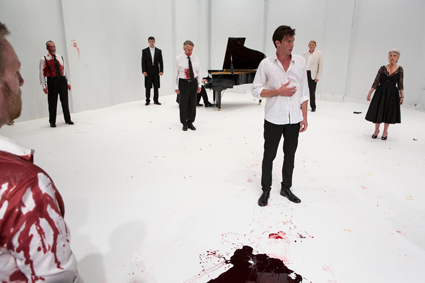
Toby Schmitz and cast of Hamlet, Belvoir
photo Brett Boardman
Toby Schmitz and cast of Hamlet, Belvoir
Harrowed, again. Having recuperated from The Maids, Persona and Angels in America (RT116), ), I found myself sucked into the vortices of madness that are Shakespeare’s Hamlet and Les Harding in John Romeril’s The Floating World in chillingly intimate productions from Belvoir and Griffin.
‘Hamlet mad or not’ has long been a subject of debate, but if ‘seeing things’ is a criterion for treatment then the Simon Stone-Toby Schmitz rendering places the prince firmly in the madhouse. His father’s ghost (Anthony Phelan) is a very palpable presence from the word go, dapperly attired in white dinner jacket, open necked white shirt and black trousers, confronting and later hugging his son and assuming the words of a gone-missing Gravedigger. As ever the stage at the end of Hamlet is littered with bodies poisoned and stabbed, but [spoiler alert] in Stone’s economised version—no sword fight, no suspense, just a kind of reportage, oscillating between then and now—the dead (including Polonius, a dripping Ophelia and the late king) stand about bleeding from their wounds, evoking no less than the Living Dead so beloved of contemporary popular culture. It’s a striking image, if grimly funny, and not altogether legible for those unfamiliar with Shakespeare’s emotionally exhausting, protracted ending.
Nor is it bumping into his father’s ghost that triggers Hamlet’s drive for vengeance. We arrive in the theatre to find him already darkly attired, perched on the edge of a chair in a state of palpable high anxiety—frowning, cheeks flushed, agitated. Blackout. Lights up—Ophelia is already in his lap. Blackout. And off we go. As with the ending, the cutting and pre-determining at the beginning feel reductive and impatient; as does the thinning out of Hamlet’s world. Horatio and others are gone, their functions briefly embodied in an anonymous figure; Laertes is rendered less significant (if finely performed by Thomas Campbell); and no Fortinbras comes to assume power after the self-destructive carnage enacted by this state. Stone’s version of Hamlet transforms it into a brisk chamber play focused overtly on the prince and, as the director did with The Wild Duck, erases the wider world Hamlet inhabits and, with it, complexities of power, role and class. Shakespeare saw the world in larger terms.
Although irritated by Stone’s ‘digest’ of Hamlet, I found enough power in the production and strengths in the performances to make for an often immersive experience. The dark curtained walls, the surrounding rows of functional chairs, a grand piano, the neat rows of designer lighting above with their almost sepia glow over an otherwise empty space, suggested a funeral parlour and, with Hamlet and his father (seated the other side of the room) casually suited, not unlike, say, the seductively smooth black and white ambience of Le Feu Follet, Louis Malle’s 1963 film about a suicidal alcoholic. The stage design evoked a time not quite our own: a not far off past, confirmed with the playing from Erik Satie’s Gnossiennes at the beginning and a countertenor in tails crossing the stage from time to time singing laments from various periods, as if at a soiree. After interval, Hamlet rolls about on an Eames chair, the stage now starkly white—no more darkness, no more secrets.
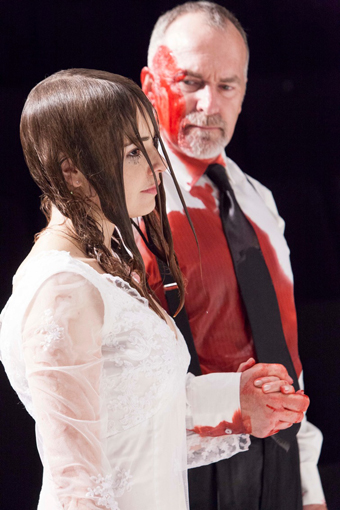
Emily Barclay, Greg Stone, Hamlet, Belvoir
photo Brett Boardman
Emily Barclay, Greg Stone, Hamlet, Belvoir
Schmitz’s Hamlet is equally introvert and extrovert, jokily engaging with the audience, hugging his father’s ghost and openly weeping, leaning over the seating balustrade to deliver “To be or not to be…” directly to us, none too anxiously, while elsewhere flattening the beat in “O that this too, too solid flesh would melt” or breaking the rhythms of lines to suggest an interiority barely in touch with the words he utters. There’s just enough legato to keep the poetry intact and emotionally engaging. Hamlet’s complexity is brought home in Schmitz’s seamless blending of deep-seated despair and indecision—realised not only verbally but with a racking, intense physicality—and wicked calculation played to the audience.
Claudius (John Gaden) in double-breasted suit and Gertrude (Robyn Nevin) in black bejewelled gown come across as an older, more formal generation, their neat, classical diction aptly tested by the anger and anguish that erupts from them in the crises they find themselves as if not believing them to be of their own making. Greg Stone, a not at all elderly, business-like Polonius, deftly, amusingly and movingly delivers his lines as if of a generation between Hamlet and his parents. Emily Barclay’s Ophelia is painfully sweet and therefore all the more victim of Hamlet’s escalating “get thee to a nunnery” rant. Unfortunately the pathos of the mad Ophelia’s (none too tuneful) singing is undercut by atonal piano tinkling.
I was surprised to hear Schmitz’s Hamlet groan as he cradled the dead Ophelia and howl at the play’s bloody climax, as did some of the living dead standing about him who then united in song as Hamlet shook and cried aloud. I know Olivier famously yowled at the end of a production of Oedipus Rex, but I’ve always felt there is enough power in the poetry of Shakespeare to not warrant such additions. Here a bit more silence before (and after) “The rest is silence” would have been welcome. Just prior to the singing, the Ghost had uttered Horatio’s “Goodnight sweet prince” confirming what we sensed from the beginning, that this production of Hamlet was to be a father-son psychodrama in which, above all, Hamlet’s guilt is writ large at the end, on a stage populated by the dead, including Hamlet himself—a veritable purgatory of existential angst. This made for a rather heavy-handed and less than cathartic Hamlet, leaving us bereft of that peculiarly disturbing and comforting Shakespearean dialectic of existential horror on the one hand and a sense on the other of completion, a return to some kind of order, even if flawed. This is a Hamlet well worth seeing, to enjoy and quarrel with.
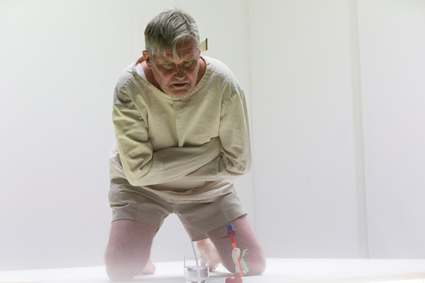
Peter Kowitz, The Floating World, Griffin Theatre Company
photo Brett Boardman
Peter Kowitz, The Floating World, Griffin Theatre Company
The Floating World
In John Romeril’s delirious cabaret of derangement, The Floating World (1974), a World War II Australian soldier who has witnessed first hand the atrocities perpetrated by the Japanese army, is on a Women’s Weekly Cherry Blossom cruise to Japan many years later. Les Harding (Peter Kowitz) is unhappy to be dragged away from the comforts of home but it simply hasn’t occurred to him that this trip might become a voyage into the past, let alone madness. His wife, a fellow passenger and the ship’s staff witness Les’s angry decline and are implicated in it, becoming projections for figures from his past. In effect Les becomes our shipboard entertainment, supplanting the crudely offensive MC with his own stream of racist and sexist wisecracks and increasingly offensive limericks which casually at first and then frantically keep nasty memories and unwelcome intimacy at bay.
Les, as with many generations of soldiers, has kept his war memories to himself, above all never speaking about feeling guilty for having survived when friends died in appalling circumstances. His defence mechanisms gradually break down, paranoia and hallucinations ensue—an Asian waiter is fantasised to be a Japanese soldier whom Les beats. Director Sam Strong and actor Peter Kowitz finely shape Les’s collapse as an increasingly intense, angry and bewildered descent into madness with fewer and fewer moments of respite. We see it coming before his companions do. Initially it’s just the sort of bad behaviour that his tolerant wife expects from Les, especially when he drinks. But by Act 2 his cruel treatment of her, triggered by unwarranted sexual jealousy, and his conversations with the dead signal a man deeply traumatised, punishing others as well as himself for the guilt he feels. The truth comes out in an enormous, painful rush, a raw soliloquy that relives horrendous experiences. Although resisting—protecting himself with a fresh barrage of limericks—he gets through his story in an internal reparation, which we hope he can translate into his relationship with his wife, friends and the Japanese.
Kowitz, in doubtless the best performance of his career, embodies all the complexities of Les, an apparently ordinary man whose repressed memories have leapt forth in the shape of the living dead who can now, at last, be spoken of and put to rest, if never to be forgotten. There is little stillness in Kowitz’s astonishingly relentless physical realisation of Les, one matched by his verbal fireworks, doing full justice to John Romeril’s rich vernacular poetry. At the play’s end, Les, emerging as “a new man,” recalls an apparently small victory of survival after being kicked into a fire by a Japanese officer:
“They scraped me out—potatoes out of the embers. I stood there swaying as he rained blows on me. I didn’t feel a thing. In the corner a bottle of vitamin B tablets poked from the top of his pack—dance like palm trees in a mirage—flowers on a cloud […] I walked in a dream—the ghost of a shoplifter in Myers returning to the scene of the crime—time stopped for everyone but me. When they left that night, two-star Corporal Yomito lacked his vitamin B supply. I lived in a floating world.”
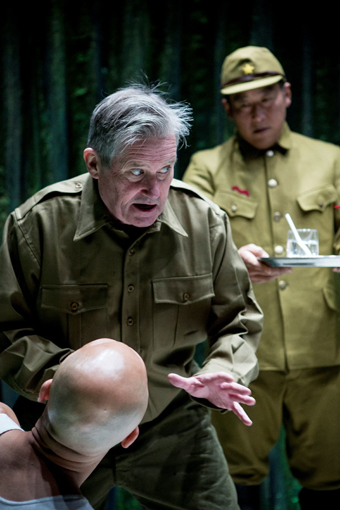
foreground Justin Stewart Cotta, Peter Kowitz, Shingo Usami, The Floating World, Griffin Theatre Company
photo Brett Boardman
foreground Justin Stewart Cotta, Peter Kowitz, Shingo Usami, The Floating World, Griffin Theatre Company
In Stephen Curtis’ aptly spare design a glittering showbizzy curtain curves behind a simple platform stage, opposite which is a keyboard for the ship’s entertainment officer. As in the second half of Simon Stone’s Hamlet, the curtain is whisked away to reveal stark white walls as madness becomes palpable and, finally, Les raves his way to salvation in a straitjacket. Sam Strong’s account is in every respect a powerful ensemble production: Valerie Bader is perfect as Irene Harding, used to casually deflecting her husband’s barbs, oblivious to her misuse of words (making her comic but no less sensitive) and now painfully confronted with a husband out of control. Tony Llewellyn-Jones is the amicable, gentlemanly former British officer whose tolerance of the abuse meted out by Les is stretched to near breaking point. Justin Smith’s comic is an aptly gross reflection of Les’s prejudices, but one without justification. Justin Stewart Cotta as ship’s musician and the long dead soldier mate McLeod is a strong, flexible performer, as is Shingo Usami as the put-upon waiter-cum-officer whose other job is to manipulate the Dippy (or Drinking) Bird (originally Chinese, then Japanese before being mass-marketed by the US)—that haunting symbol of balance and the absence of real autonomy—that Romeril employs between scenes. Kelly Ryall’s sound score is aptly eerie, resonant with the play’s many unsettling, floating signifiers, not least the reverberant title which ironically analogises the crude shipboard entertainment with Japan’s sophisticated cultural underworld and then Les Harding’s lost soul.
Save for a slightly stiff staging of the play’s final lines (delivered by three of the cast instead of two) this production of The Floating World is superbly unnerving, confirming once again that the play is indeed an Australian classic, a phrase tossed about too easily these days.
Ewen Leslie replaced Toby Schmitz as Hamlet from November 19.
The Floating World will play at Riverside Theatres, Parramatta, 19-23 Nov, http://riversideparramatta.com.au/show/the-floating-world/
Belvoir, Hamlet, writer William Shakespeare, director Simon Stone, designer Ralph Myers, costumes Mel Page, lighting Benjamin Cisterne, music, sound Stefan Gregory, Belvoir Theatre, 16 Oct-1 Dec; Griffin Theatre Company, The Floating World, writer John Romeril, director Sam Strong, The Stables, Sydney, 4 Oct-16 Nov
This article first appeared in RT’s online e-dition 13 November, 2013
RealTime issue #118 Dec-Jan 2013 pg. 38
© Keith Gallasch; for permission to reproduce apply to realtime@realtimearts.net
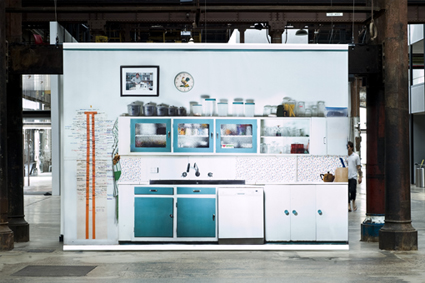
The Ronalds, Habits & Habitats (2010)
courtesy the artists
The Ronalds, Habits & Habitats (2010)
In 2010, Performance Space commissioned the artist duo Ronald & McDonnell to make a work for the cavernous Carriageworks foyer (see RT96). Habits & Habitats comprised a series of large 1:1 scale photographs of interior spaces of an average house in rural NSW, printed on canvas panels hung to intersect the space.However something seemed not quite right, or in fact everything seemed too right, too perfect. There was a clarity and flatness to these banal depictions of rural domestic living that rendered them startlingly vivid, the viewer’s attention drawn to normally unnoticed details. While there was an opportunity for parody here, it wasn’t taken; this work offered rather a sense of serious ethnography.
The curious flatness was achieved by taking hundreds of equidistant close-up photos of elements in the room, identical parameters applied to each shot. The interiors were then pieced back together using Photoshop to form the room-sized panels. This level of painstaking detail and its hyperreal results remain a dominant element in the practice of this duo, now conjugally joined, working simply as The Ronalds.
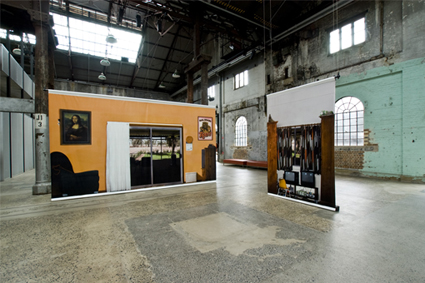
The Ronalds, Habits & Habitats (2010)
courtesy the artists
The Ronalds, Habits & Habitats (2010)
The power of more than one
The Ronalds met when they were both studying Photomedia at Charles Sturt University; it seems their shared aesthetic finds its roots in the lessons learned there. Shannon Ronald says, “We were taught at CSU that one photo was never enough. If you’re going to do anything, especially with a series you’ve got to prove that you can reproduce what you’re doing. So we’ve come up with ideas to make huge series.”
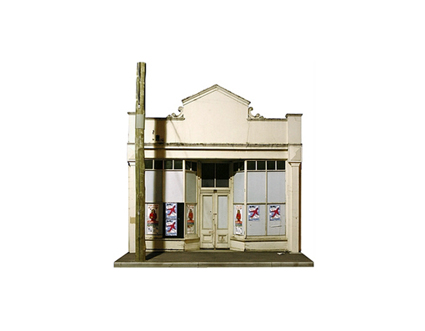
The Ronalds, Microcosm (2005)
courtesy the artists
The Ronalds, Microcosm (2005)
Their first collaborative series was made in Launceston, where the couple moved after they finished university in 2005. In Microcosm they took photos of the facades of buildings that were proposed for heritage listing. The photos were captured at night, on long exposures, to give a unified sense of light and then cut out from the background. Exhibited as small-scale photographs the images have the preciousness of miniatures (something The Ronalds are particularly interested in), emphasising the importance of heritage and preservation.
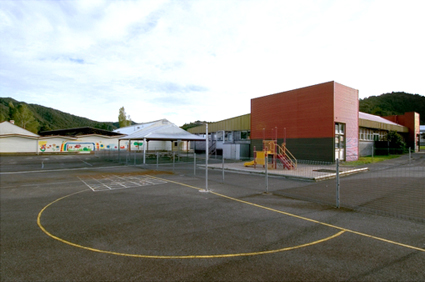
The Ronalds, Queenstown school, Disappearing TASMANIA (2006)
courtesy the artists
The Ronalds, Queenstown school, Disappearing TASMANIA (2006)
The couple then received funding to undertake the Disappearing TASMANIA project where they sought to document towns on the west coast that were in rapid decline. Patrick Ronald explains, “We both started out doing social documentaries and then we moved away from the people. We found that buildings and the things that people created were more interesting to us than going and interviewing someone. We felt that we were imposing. We didn’t really know these people: you’ve only met them for an hour or so and then you’re making judgements about their lives. But in something like Disappearing TASMANIA, we showed these totally empty, pristine classrooms just waiting for kids that probably will never turn up.” The haunting series allows the power of the place and artefact to speak for themselves.
Perhaps not surprisingly, given the exactitude of their processes, statistics often play a large part in their idea generation, and Shannon Ronald suggests this keeps the projects focused. “[We often use] data collection, which is weird but it gives us good reason and when we’re both on track we know what we’ve chosen to take photos of and it all seems to work out. We’ve got the same vision.”
This unified vision is complemented by intersecting skill sets. Patrick describes his skill as being “able to take a million photos exactly the same and Shannon’s being able to Photoshop like a wizard.” Shannon says, “I think the main reason that we work together is that when you’re editing each other, it’s bound to be a better project because you’re not just looking at it yourself and thinking this is a great project. You’ve got to convince someone else first before it goes out to the rest of the world.”
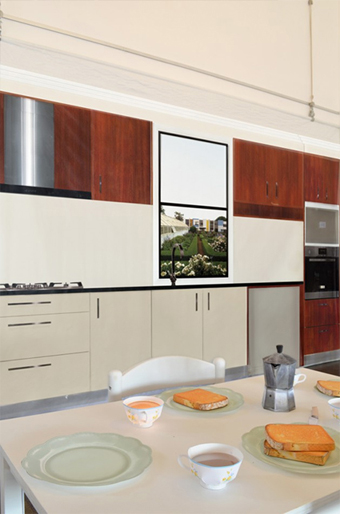
The Ronalds, Roxy Theatre Art Space, Leeton
courtesy the artists
The Ronalds, Roxy Theatre Art Space, Leeton
From flatness to 3D to virtuality
The Ronalds’ latest projects have extended their experiments in recombinatory photographic realism into the third dimension. For their show at the Roxy Art Space in Leeton, they filled the gallery with three-dimensional photographic objects depicting a domestic dining and lounge room. As Shannon Ronald describes it, “The toast isn’t toast, it’s a toast-shaped photograph, and the plate is a plate-shaped photograph.” These are created by taking photos of each facet of an object, laying them out digitally as a flat schematic, then printing, cutting and folding them into object-shaped boxes.
For the Leeton show, they went one step further and “game-ified” the installation. Shannon, a self-confessed Nintendo freak since childhood, created a basic game where the character, Foxy, wanders around the streets of Leeton, the backgrounds borrowed from Streetview. Actions in the game, like pressing a button, activate some of the 3D photographic objects in the space, making them light up thus providing clues to the player as to where to head next in the video game. The whole gallery space was also linked to online viewers, so participants could get involved remotely.
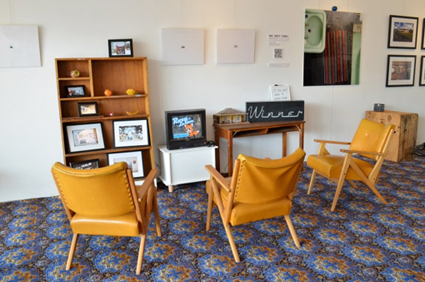
The Ronalds, Roxy Theatre Art Space, Leeton
courtesy the artists
The Ronalds, Roxy Theatre Art Space, Leeton
This online interaction prompted Greg Pritchard (then arts development officer for Western Riverina Arts) to suggest a collaboration between himself and The Ronalds to be presented at Underbelly on Cockatoo Island in Sydney. Titled Virtual Reality, the project connected Underbelly audiences directly with a number of artists in the Riverina district via video streaming and text messages. The audience could interact, ask questions and get the artists to do things for them, with the artists at their beck and call for an eight-hour stint. It was part conversation, part art-reality TV, forging real-time connections between the urban and rural environments.
Keeping it local
The Ronalds’ next project seems like a combination of all their activities to date. Commissioned by the Wagga Wagga Regional Art Gallery to create a work celebrating its 40th birthday, the Ronalds have committed to a three-year project titled In Common. They are planning to make 300-800 miniature photographic sculptures depicting places, objects and structures from the 130 towns in the Riverina/Murrumbidgee region. They will visit all of the towns and have asked residents to nominate and vote on what should be shown. These sculptures will then be installed in the gallery emulating a map of the region, with some game-ification elements. The biggest problem for the artists now is whether they have enough time to make all these objects for the exhibition opening in 2015. The scale of the project is a mark of their commitment to the region and to documenting its true character, before perhaps it disappears.
While The Ronalds did live in Sydney for a while, they realised it suited them best to live in a more rural environment. Patrick Ronald says, “Your upbringing really effects how you become an artist and the issues you talk about. We don’t talk about our own personal lives but I guess we show our lives—this commonality between regional towns. And we’re proud to go and live in these little towns. As photographers we thought what the guys in 1970s in America did was cool, when they got in cars and drove around doing those big road trips. I guess we kind of emulate them in contemporary ways.”
Shannon concurs. “The way that Patrick and I work, I don’t think we’re missing out on anything at all by being out here, except for the fact that my internet’s a bit flat; but other than that I don’t think there’s anything holding us back…Regional people mean a lot to us because they provide us with all of our ideas. And we like it here.”
http://www.theronalds.com.au
RealTime issue #118 Dec-Jan 2013 pg. web
© Gail Priest; for permission to reproduce apply to realtime@realtimearts.net
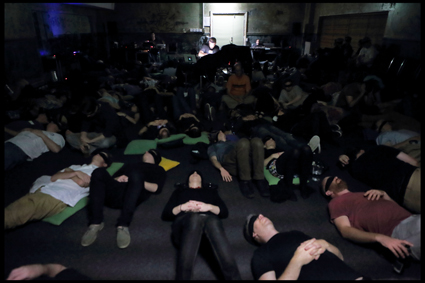
Francisco López, Open Frame
photo Lawrence English
Francisco López, Open Frame
Noise comes in many flavours—mathematical, aesthetic, seductively transgressive, coolly liberating, unwanted and annoying. For this year’s open frame series from room40 we find “The Future is Noise,” a snappy title that mashes together two classics of the noise-in-music literature: Luigi Russolo’s prophetic The Art of Noises (1913) and John Cage’s astute The Future of Music (1937).
Noise has been around in music for a long time (dogs barked out a hit version of Jingle Bell’s in the 1950s), so maybe the future is just more of the same. I struggled to see how some of the artists on the 2013 Open Frame program could be shoehorned into a sensible framework that either referenced past visions of noise or projected into some increasingly noisy future. Nonetheless, across three nights in September great work was to be heard, and that great work was from Spain’s Francisco López.
López is a master of sounds jemmied away from their source to be heard in and of themselves. As he puts it “I believe in the possibility of a profound, pure, ‘blind’ listening of sounds, freed (as much as possible) of procedural, contextual or intentional levels of reference.” This is the tradition of acousmatic sound, where all the meanings attributed to a sound come through the sound alone, with no visual or other perceptual linkage. It’s the oracular voice from behind the curtain and the hurry-up of the horn from the cab in the street outside.
For López, though, it is around the fire at night and an unexpected crack of twig outside the circle of light. Everyone goes quiet, heads turn in the direction the sound came from, then are held still, waiting. Bodies shift, ready for action and vision relaxes. Listening is all. There is another crack, the sound of a heavy foot slowly and carefully pressing down on a large dry twig, then another and another, faster and faster, closer and closer …
The López concert, or as he calls it, “our little ceremony,” begins with everyone blindfolded and lying in a circle, heads to the centre, feet to the rim, speakers all around. López stands unseen in the middle, controlling the mix. A ceremony, with no celebrant to pull the focus away from…pure sound. This concert, a single work of about 45 minutes (more? I completely lost track of time), is structured into lengthy sections punctuated by silence and (recorded) spoken voice. The sounds are sometimes clearly recognisable, sometimes not, the recording quality always exceptional.
But this is not pure sound in the Cagean sense of isolated sound events arbitrarily sequenced for our detached contemplation. Tonight’s sounds are deliberately and skilfully pulled into an abstract and emotional narrative. It is perhaps López’ background in biology (entomology) that leads to work that seems to compel emotions deeply connected to survival rather than pleasure. We hear a pig-like beast grunting, snuffling and eating something or other. Interesting sound and a bit funny in the way piggy things tend to be. More pigs join the meal and the noise of their biting, grinding and swallowing is relentless and huge, all around as we lie blindfolded on the floor. The implication is clear—if you are on the ground, pigs up close and voraciously eating, then you are being eaten. From a charming funny sound to being eaten alive.
Or as López asks, “why have happiness when you can have intensity?” But how is that intensity possible when the sound is stripped from all and any visual referent? Sound carries with it information about the world. Objects vibrate for a reason, those vibrations travel through the air, bringing their reason for being to the exquisitely sensitive mechanisms of the ears, which then vibrate in sympathy, delivering information about movement, time and space. While those vibrations may be from the rustle of fabric as it drops to the floor, the drip of water after the rain has stopped, or the sound of leaves in the upper branches as the cool change moves in, they may also be the sounds of an unexpected car, a quick gust of wind, the door slamming shut and a suddenly silent child.
These are the sounds of López, sounds of intensity and not comfort. For while vision might show that a knife looks sharp, sound brings the scrape of knife on bone.
Room40, Open Frame, The Future is Noise, Francisco Lopez, Brisbane Powerhouse, 12, 13, 19 Sept
RealTime issue #117 Oct-Nov 2013 pg. web
© Greg Hooper; for permission to reproduce apply to realtime@realtimearts.net
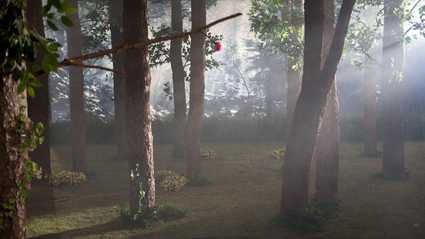
Yeondoo Jung, Documentary Nostalgia, video still, 2007
Two films from Korean artist Yeondoo Jung. Both take us through the construction of a naturalistic scene showing how the illusion is created with photorealistic backdrops and crafty props. Twilight Seoul is 8 minutes with Yeondoo and collaborator Luka Fineisen chatting away in the studio as they mound up blocks of wood, squashed cardboard boxes, bits of fluff, a woolly cap and a stuffed cuddly tiger. They stop the chat, a backdrop is pulled across, the lights go dim and the shadows deepen between the piles of junk. Fog rolls across the floor, a lonely bird cries out in the silence and, like a miracle, a jumble of absolute crap becomes Sacred Mountains in the Twilight.
The slowly fascinating documentary Nostalgia is an 84-minute single take of the construction of various scenes from Yeondoo’s memory. Opens on a bare room, floral wallpaper, classic perspective shot. Man in neat orange coveralls comes in and hangs a painting, goes back out, comes back in with a table, a rug, a vase and flowers. Sticks a couple of power points on the wall, plugs in a lamp, turns it on—even though it is a fake. Someone else comes in, turns off the lights, goes out, things start shaking, the whole scene starts to move and we see a bunch of guys in orange roll the room away on a trolley to reveal….
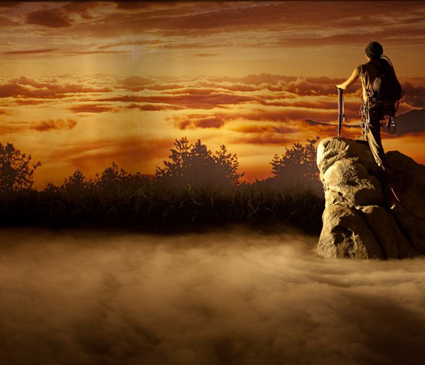
Yeondoo Jung, Documentary Nostalgia, video still, 2007
A studio set up like a classic street scene with shops and a bus stop. The orange guys lug in a carpet and roll out an instant bitumen road with white dashes down the middle. A minivan is pushed in and a man and a woman step out, go wait at the bus stop. Smart casuals. It starts to rain and a man holding a briefcase over his head for protection runs to the bus stop and…everything freezes into a photo—Urban Street in the Rain. This is the format—activity and construction of various set pieces that from time to time freeze into a photo op. The past as the construction of a snapshot.
The more or less continual transformation of scenes continues—now it is a rural scene with real bird on tree branch but fake bouncy eggs in the nest. Fake grass and a wooden fence. Lead in a cow who munches feed from a wooden trough and is not at all keen to shuffle off stage and leave that food behind when her time is up. Trees are carried on and there’s a sun-dappled forest, then even more trees for a thicker forest in moonlight. Finally a panoramic sunset backdrop is wheeled in and thick fog spills over the ground. A rocky peak pushes up through the fog and a mountaineer, rope coiled over his shoulder, clambers to the top and peers into the distance. He poses as the lonely Hero from Caspar David Friedrich’s “Wanderer above the Sea of Fog.” Story and recollection have meshed into memories held still for the perfect photo. Cut! And roll credits.
Yeondoo Jung, MAAP Space, Brisbane, 27 Sept-8 Nov; http://www.maap.org.au/projects/maap-space/
RealTime issue #117 Oct-Nov 2013 pg. web
© Greg Hooper; for permission to reproduce apply to realtime@realtimearts.net
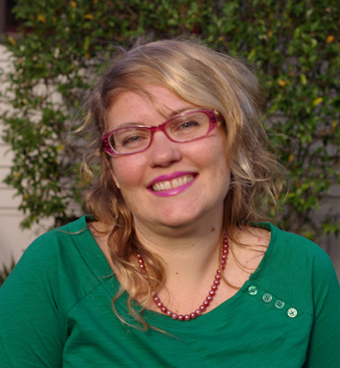
Kathryn Kelly
Bio
I only ever wanted to be a dramaturg when I grew up. I trained at the University of Queensland, where I did an Honours thesis on Australian female playwrights of the 1940s before heading over to Toronto to work as a freelance dramaturg.
Over the last decade or two I’ve run an international young playwrights festival (Interplay), a small publishing house (Playlab) and done my stints in arts policy for Arts Queensland. I’ve worked for all of the script development agencies in the country, had credits for shows with every professional company in Queensland and most of the independent ones. My dramaturgical practice includes new writing, contemporary performance, dance, circus and cabaret.
I am gladly freelancing again after the birth of my first child, Elsie, doing a PhD on how to teach dramaturgy while teaching dramaturgy around town at various universities, TAFE and, of course, reviewing for RealTime.
Exposé
My dramaturgical hero has always been the theatre critic Kenneth Tynan. Many love him for defining the eternal cultural hipster look: black turtleneck plus bottle-top glasses. I worship him because through sheer wit and intellectual capacity he wrested dramaturgy from the Germans and brought it into English theatre.
Alas, as a cuddly blonde I’ve never been able to pull off the black, but I have always wanted to review. Not in the snarky journalistic tradition that is the excuse for most of what fills up newspaper columns in Australia, but in the wholehearted and generous dramaturgical tradition of Tynan, who always sought to privilege new work and experimentation by finding a way to write about performance that opened it up even for the most conservative or disengaged of his readers. When we talk about ‘angry young men’ or ‘Brechtian gestus’ we are still swimming in Tynan’s sea.
In Australia, the professional performance sector is marginal, surviving through a perilous combination of public subsidy and individual artists’ passion. We practice, in our tribal groups, often trapped by the geographic boundaries of our city-states. We rarely have the time or money to look up.
RealTime is our way of making a national community of performance. As a long-term RT reader that is always why I have religiously picked up my copy, to find out what was happening elsewhere, to see who was making what with whom and whether it was any good?
And this is probably the thing that I treasure most about RT: I can rely on it to provide me with a balanced and articulate account of the national performance scene. This is no small feat. As Alison Croggon noted in the journal Kill Your Darlings on closing her very much missed blog, theatre notes, RT was the only useful source of theatre criticism when she started writing about performance. RT gives you the taste, the moment, the feeling of the show, and it has been so delicious to engage in performance writing in terms of legacy and context. Vive la RT!
Selected articles
Expecting the unexpected
Kathryn Kelly: La Boite Indie Season; Judith Wright Centre, Fresh Ground
RealTime issue #116 Aug-Sept 2013 p39
Celebrating the body: plasticity & mutation
Kathryn Kelly: exist-ence 5, festival of live art, performance art and action art
RealTime issue #116 Aug-Sept 2013 p40
Cultural resurgence on the Gold Coast
Kathryn Kelly, Gold Coast
RealTime issue #115 June-July 2013 p24
15 minutes of fame & death after supper
Kathryn Kelly
RealTime issue #114 April-May 2013 p44
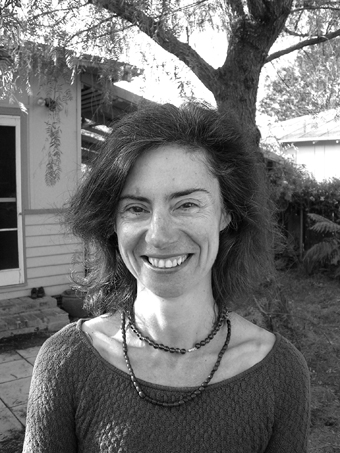
Zsuzsanna Soboslay
photo Tim Moore
Zsuzsanna Soboslay
Bio
I am a performer, writer and artist who has been engaged in creative collaborations across the arts for over 20 years. I teach and research in the tertiary, pre-school and community (including mixed ability) arts sectors, and write and create performances on the themes of environment, ecology, and the experience of refugees. I specialise in collaborative work across disciplines and have held residencies at Bundanon, ACT Early Childhood schools, the National Film and Sound Archive, Canberra Dance Theatre and in September I participated in the Kultour Gathering in Brisbane. Recent public performances include: National Gallery of Australia (a dance-biography of Jane Avril), CSIRO DANscienCE Week, Floating Land in the Noosa Biosphere.
Two current projects, Welcome/Unwelcome and Anthems and Angels are process-oriented performance/installations combining archival materials with real-time acoustic and electronic interactions, transforming fragments of sound, movement, and oral histories that constitute the memories of people in transition (from one country to another, into parenting, illness or ageing). Collaborators include Timothy Constable (Synergy Percussion), Kimmo Vennonen (sound), Franki Sparke (animations) and film-maker Michael K Chin (Tokyo Love-In).
www.bodyecology.com.au/; http://www.youtube.com/watch?v=1JOd6vmOR0U.
Exposé
I think art is a process of listening to something that is there, trying to become known. Essentially I think a critique is part of the same continuum—engaged in a process of deep listening to an experience that needs telling, seeing or performing.
Writing uncovers things I sense but around which I may not yet have a framework. The best performance works ignite sensations that reconfigure, or re-ignite, who or where I am in the world, and I find it almost a relief to write in order to understand what I have just witnessed unfold.
Works that fulfill themselves can be a delicate pleasure to discuss: works that are on the way can be more arduous, but equally demanding of full-blooded honesty.
Sometimes I feel my role is to hear the big voice of the small animal, particularly if it’s still struggling to make itself heard. I don’t’ always feel respected for that. I’ve tried to give up reviewing, but always the sense of honouring something that needs to be witnessed wins the day and I come back to it, again and again.
The best responses I’ve had to my reviews [whether on art, dance, theatre or music] have been ‘it’s just like I’m there alongside you’. With that kind of feedback, I feel I’ve fulfilled my role.
Selected articles
Opera: individual passion, collective tragedy
Zsuzsanna Soboslay: Sandra France, Helen Nourse, From a Black Sky
Lives surviving disarray
Zsuzsanna Soboslay: Urban Theatre Projects, Catalogue of DreamsRealTime issue #117 Oct-Nov 2013 p31
Sharing country
Zsuzsanna Soboslay: QL2’s Quantum Leap, Hit the Floor Together
RealTime issue #117 Oct-Nov 2013 p22
Asleep but awake and dancing
Zsuzsanna Sobolsay: QL2 Dance Theatre, Noplace
RealTime issue #110 Aug-Sept 2012 web
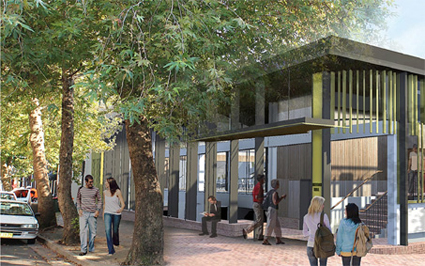
Heffron Hall, image courtesy Lahz Nimmo Architects
Public Art, Heffron Hall, City of Sydney
Many Sydney artists would be familiar with Heffron Hall since it’s been the home of Brand X—formerly Queen St Rehearsal enterprises—for the last few years. It’s oon to be revamped by the City of Sydney which is seeking proposals from artists for commissions for the new lobby.
Tenders due 6 Dec; http://www.cityartsydney.com.au/cityart/news/?p=1871
Westspace
Due to committed fund raising Westspace’s galleries in Melbourne will be rent free in 2014. If you’re quick about it you can still get in an online application for available exhibition spots in the second half of 2014.
Due 8 Nov; http://westspace.org.au/applications/how-to-apply
Exposure Summer Intensive, Tasdance
Launceston-based Tasdanceis offering a two-week summer intensive with Kialea-Nadine Williams for emerging dancers (13-17 Jan & 20-24 Jan). The program will include technique classes as well as the creative development of solo and group choreography with an informal showing at the conclusion. Participants may elect to do one or two weeks of the program.
Applications currently open; http://tasdance.com.au/exposure/; for more info email richard@tasdance.com.au
CJZ/Rock Surfers New Writing Commission
Rock Surfers Theatre, current company in residence at Bondi Pavilion, Sydney, have teamed up with media production company Cordell Jigsaw Zapruder (CJZ) to offer a $12,500 writing commission for a new theatre work. Playwrights who have had a work produced or published since 1997 (when the Rock Surfers were founded) are eligible to submit a pitch. The new work will be performed as part of their 2014 season.
Deadline 2 Dec; http://rocksurfers.org/newwords/
Still in the loop
CCP Salon 2013
Deadline 8 Nov; http://www.ccp.org.au/salon_2013.php
AEAF—emerging + experimental curators
Applications due 8 Nov
www.eaf.org
Renew Sydney: Leichhardt
Proposals due 8 Nov
http://www.renewaustralia.org/2013/10/renew-australia-comes-to-sydney-with-renew-leichhardt/
First Draft Directors 2014-2015
Deadline 8 Nov
http://firstdraftgallery.com/get_involved/firstdraftwantsyou
Courthouse Arts Visual Arts Program
EOIs due 15 Nov; http://courthouse.org.au/on-now/searching-for-a-young-curator-for-2014/
Editor, Un Magazine
Applications due 25 November 2013; http://unprojects.org.au/magazine/contribute/
Waterwheel Symposium Call for Participation
Proposals for Symposium due 22 Nov; proposals for Voice of the Future Youth Day, 31 Dec; http://water-wheel.net/
Selected Australia Council Grant Deadlines
(for full list go to http://www.australiacouncil.gov.au/grants
Music: Presentation and Promotion – 18 November 2013
http://www.australiacouncil.gov.au/grants/2013/music-presentation-and-promotion-18-november
Music: New Work – Writing and Recording – 18 November 2013
http://www.australiacouncil.gov.au/grants/2013/music-new-work-writing-and-recording-18-november
Aboriginal and Torres Strait Islander: Skills and Arts Development –
19 November 2013
http://www.australiacouncil.gov.au/grants/2013/aboriginal-and-torres-strait-islander-arts-skills-and-arts-development-19-november
Aboriginal and Torres Strait Islander: Presentation and Promotion-
19 November 2013
http://www.australiacouncil.gov.au/grants/2013/aboriginal-and-torres-strait-islander-arts-presentation-and-promotion-1-april
Aboriginal and Torres Strait Islander: The Dreaming Award –
19 November 2013
http://www.australiacouncil.gov.au/grants/2013/dreaming-award
Aboriginal and Torres Strait Islander: Fellowships –
19 November 2013
http://www.australiacouncil.gov.au/grants/2013/aboriginal-and-torres-strait-islander-arts-fellowships
Aboriginal and Torres Strait Islander: The Red Ochre Award –
19 November 2013
http://www.australiacouncil.gov.au/grants/2013/red-ochre-award
Aboriginal and Torres Strait Islander: New Work –
19 November 2013
http://www.australiacouncil.gov.au/grants/2013/aboriginal-and-torres-strait-islander-arts-new-work-19-november
Visual Arts Travel Fund – 25 November 2013
http://www.australiacouncil.gov.au/grants/2013/Visual-Arts-Travel-Fund
Contemporary Music Touring Program – 25 November 2013
http://www.australiacouncil.gov.au/grants/2013/contemporary-music-touring-program-25-november
RealTime issue #117 Oct-Nov 2013 pg. web
© RealTime ; for permission to reproduce apply to realtime@realtimearts.net
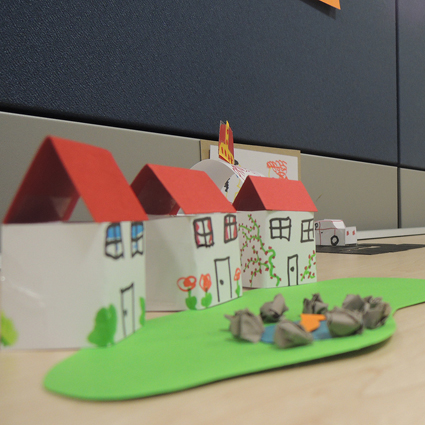
This is a Door, Pop-Up Playground
This is a Door, Pop-Up Playground
In two recent articles for RealTime Robert Reid has been preoccupied with play and now we know why (see RT117 & RT115). He is one of the core members of Pop-Up Playground presenting the This is a Door festival in Melbourne, a month-long program of participatory experiences and games. If you want to join the fun you can decide on the fate of the city with the Urban Codemakers (see the realtime tv interview with Troy Innocent about the ISEA instalment Zydnei); find and fight monsters in Pub Werewolf; make unicorns with the Nylon Zoo; or discover haiku bombs made by guerilla poets. On the final weekend, Theatreworks in St Kilda will be transformed into a massive “playroom” for back-to-back adventures. Just to be clear here, we’re not talking computer games—this is real world fun.
This is a Door, Pop-Up Playground, Theatreworks and various venues, St Kilda and Melbourne City; http://popupplayground.com.au/this-is-a-door-2013/
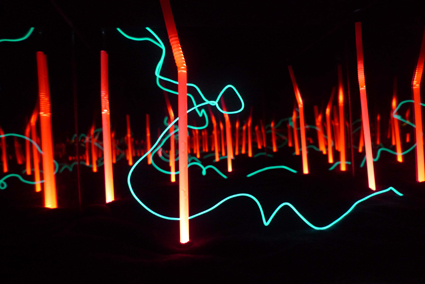
Belinda Middlebrook’s Wood Bird, part of Wagnerlicht
courtesy the artists
Belinda Middlebrook’s Wood Bird, part of Wagnerlicht
Wagnerlicht, Arts Centre
Celebrating the bicentenary of Richard Wagner’s birth, Wagnerlicht is a multimedia installation inspired by his most famous opera Der Ring des Nibelungen (The Ring Cycle). Conceptualised by Michael Day this installation of light, sound and sculpture is realised with input from design and sound students from the University of Technology Sydney and the University of Applied Sciences in Ansbach, Germany. The interactive installation (especially for those who couldn’t afford or missed out on tickets for the Opera Australia production soon to premiere in Melbourne) allows audiences to re-intrepret the Ring Cycle and engage with the epic in new, intimate ways.
Wagnerlicht, Arts Centre Melbourne; 15 Nov-14 Dec; http://wagnerlicht.com
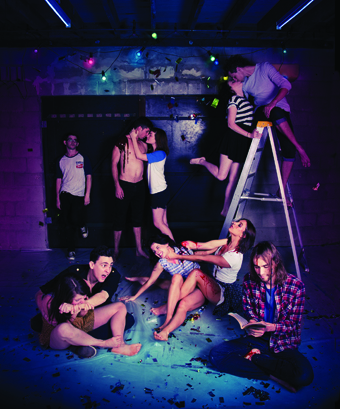
The Breadbeard Collective, R & J, La Boite Indie with QPAC
photo Al Caeiro
The Breadbeard Collective, R & J, La Boite Indie with QPAC
R&J, La Boite Indie
Shakespeare’s Romeo & Juliet, every generation has to have their crack at it. The final La Boite Indie show sees ten young people (18-25) remixing the tale, “hanging new meat on the skeleton of the story” (website). Directed by Lucas Stibbard and devised with The Breadbeard Collective it looks like it’ll be a wild party.
La Boite Indie: R & J, La Boite Roundhouse Theatre; Brisbane, 13- 30 Nov; http://www.laboite.com.au/cms/page.asp?ID=21
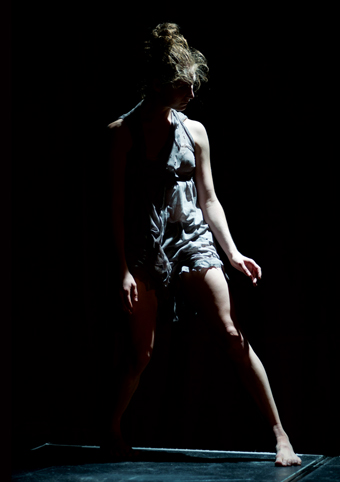
Jacqui Claus, Standing Bird 2
courtesy the artist
Jacqui Claus, Standing Bird 2
Standing Bird Two & Verge, The Blue Room
Perth’s The Blue Room is presenting a micro-season of dance featuring Sally Richardson’s Standing Bird 2 and Patrice Smith’s Verge. Standing Bird Two, performed by Jacqui Claus, continues to explore the struggle of transformation seen in the first installment of Standing Bird at Fringeworld 2012 (see Maggie Philips review RT108.) For this piece the performance leaves the theatre to be sited around the Blue Room venue. Verge, performed by Claus with Laura Boynes and Bernadette Lewis, plays with ideas of tension and release, “unease and the quiet discomfort before someone loses control” (website).
Standing Bird Two, director, concept Sally Richardson, movement director Danielle Micich, 12-29 Nov; Verge, choreographer Patrice Smith; 13-30 Nov; The Blue Room; http://blueroom.org.au/
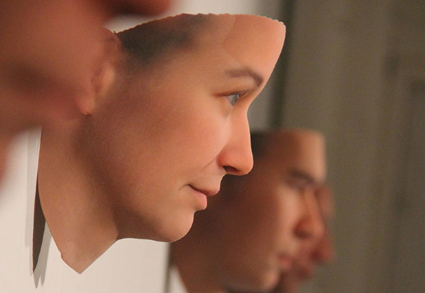
Heather Dewey-Hagborg, Stranger Visions 2012, Trace Recordings
courtesy the artist
Heather Dewey-Hagborg, Stranger Visions 2012, Trace Recordings
Trace Recordings, UTS Gallery
Curated by Holly Williams and Chris Gaul, Trace Recording features 11 artists’ responses to the increasing pervasiveness of surveillance in the everyday. Heather Dewey-Hagborg (US) uses DNA sampled from discarded cigarette butts and chewing gum to generate 3D printed portraits. Recently featured in ISEA2013, Italian artist Paulo Cirio’s Street Ghosts haunt the streets—featured in life size posters of people taken from Streetview, pasted-up in situ. Adam Harvey (US) plays with the idea of urban camouflage via “dazzle” techniques to trick facial recognition software. Denis Beaubois (Australia) is vengeful, turning the surveillance technology back on itself using mirrors to create a closed loop. There is also a program of workshops and talks.
Trace Recordings, artists Denis Beaubois, James Bridle, Mahwish Chishty, Paolo Cirio, Heather Dewey-Hagborg, Benjamin Gaulon, Adam Harvey, Trevor Paglen, Shinseungback Kimyonghun and Matt Richardson; UTS Gallery; until 29 November; http://www.art.uts.edu.au/gallery/current/index.html; http://www.tracerecordings.net/
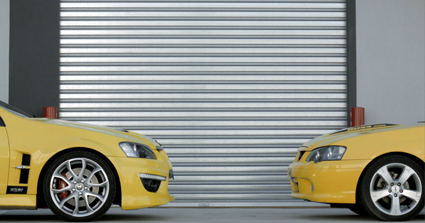
Brendan Lee, The Great Divide: RevHeads
courtesy the artist
Brendan Lee, The Great Divide: RevHeads
Brendan Lee, The Great Divide: RevHeads
At The Front Gallery in the Melbourne Docklands, Brendan Lee takes on the great Aussie car battle between Ford and Holden. In the first of what will be a series of videos, Lee “questions the identification with an evolving Australian archetype and how this is both transformed and perpetuated through popular competitive representations and iconic brands” (website). Burn rubber to get there.
Brendan Lee, The Great Divide: RevHeads, The Front, Docklands, open 9 Nov, http://www.brendanlee.com/site.php
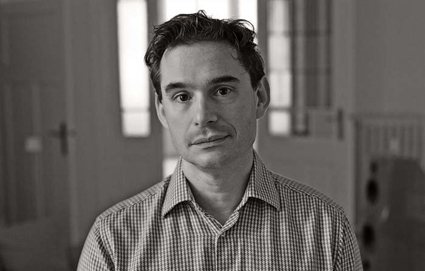
Markus Popp (aka Oval)
courtesy the artist
Markus Popp (aka Oval)
Markus Popp, National Film and Sound Archive
Father of glitch, Markus Popp (aka Oval) is currently in Australia courtesy of the Goethe Institut. He’ll be performing a free concert at the National Film and Sound Archive, Canberra this weekend supported by Hinterlandt and local boys Spartak.
Markus Popp, NFSA Theatrette, Canberra, ACT, 9 Nov; http://www.nfsa.gov.au/calendar/event/4954-markus-popp/
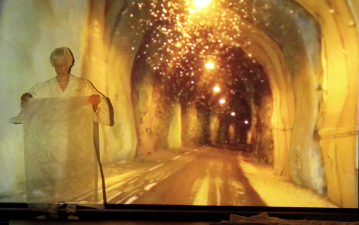
Joan Jonas, Reanimation, dOCUMENTA 13
photo by Maria Ruhling
Joan Jonas, Reanimation, dOCUMENTA 13
Performa, New York
For those lucky enough to be in the Big Apple, Performa has kicked off with a month of amazing performance and live art. There is an insane number of events but possible highlights include Jérôme Bel with Theater Hora Disabled Theater; Seminal Polish collective Akademia Ruchu’s participatory performance for Time’s Square; fictional art star Eleanora Antinova; Cifford Owens’ five-day durational performance; and Joan Jonas’ multimedia installation, Reanimation. There’s a strong sense of historicity running through the program with Malcolm Le Grice and Guy Sherwin recreating some of their seminal expanded cinema and video works; Fluxus founder Benjamin Patterson presenting a retrospective of his actions as compositions; and the Martha Graham Company revisiting two works from Graham’s Surrealist period.
Performa, various venues New York City, 1-24 Nov; http://13.performa-arts.org/
Still in the loop
Carnival of the Bold, Changemakers Festival
national 1-10 Nov
http://changemakersfestival.org/
Carnival of the Bold, New Theatre, Newtown, 9 Nov
http://changemakersfestival.org/event/carnival-of-the-bold/
My Avant-Garde Is Bigger Than Yours, Kings ARI
1-23 Nov 2013
http://www.kingsartistrun.com.au/
Crash Course, James Berlyn
PICA, 14-30 Nov
http://www.pica.org.au/view/Crash+Course/1745/
[CTRL][P] Objects on Demand, Object Gallery
15 Oct 2013 – 25 Jan 2014
http://www.object.com.au/exhibitions-events/entry/ctrl_p_objects_on_demand/; http://ctrlp.com.au/
Lorraine Heller-Nicholas, Love Story, Videobrasil
Southern Panoramas, 6 Nov-2 Feb
http://site.videobrasil.org.br/festival/arquivo/festival/programa/1589140
Daniele Puppi 432 Hertz, Cinema Rianimato e Dintorni, AEAF
1 Nov-7 Dec
http://www.aeaf.org.au/exhibitions/danielepuppi.html
Simple Forces, Joyce Hinterding
BreenSpace
25 Oct-23 Nov
http://www.breenspace.com/
Reinventing the Wheel: the Readymade Century
MUMA
3 Oct-14 Dec
http://www.monash.edu.au/muma/exhibitions/upcoming/readymade.html
The Double World, tranSTURM
Newington Armory, Sydney Olympic Park
19 Oct-10 Nov
http://www.sydneyolympicpark.com.au/whats_on/arts_and_culture_events/exhibition_the_double_world_spr13
http://cargocollective.com/transturm/the-double-world
Bogong ELECTRIC
Bogong Village, North East Victoria
1 Nov-1 Dec
http://bogongsound.com.au/
RealTime issue #117 Oct-Nov 2013 pg. web
© RealTime ; for permission to reproduce apply to realtime@realtimearts.net
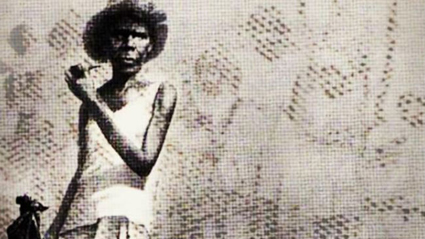
Forced Legacy—The Story of Alyngdabu
courtesy the artists
Forced Legacy—The Story of Alyngdabu
A tall, thin Aboriginal woman wearing a slouch hat and holding a tobacco pipe in one hand and a cloth bag attached to a stick in the other is the striking central image in Forced Legacy—The Story of Alyngdabu. In a painting by Robert Ingpen she looks assertively at the viewer and, as the play reveals, was a formidable woman of her time. A Kungarakan woman who married Irishman Stephen McGuinness in the early 1900s, Alyngdabu raised five children in Kungarakan country, the Bynoe Harbour area of Darwin.
The play tells her story—her happy marriage to Stephen, their tin mining venture and then how the children were forcibly taken from her and placed in the Kahlin Compound for “half castes” when her husband died. It is a story of love, injustice and survival told with pride by Alyngdabu’s descendents Kathy Mills and her daughter Alli Mills with dramaturgical and directorial support from Damian A Pree.
Kathy and Alli are well known Darwin activists, artists and musicians who have been telling their stories through various mediums for many years and campaigning for a shrine of remembrance on the now empty site where Kahlin Compound once kept hundreds of Stolen Generation children. This theatre work is a collaboration with Friends of Kahlin and commemorates the centenary of the compound.
It is an important story to tell and moved some of the Brown’s Mart audience to tears. Sitting in front of a scrim used for projecting historical images of traditional Aboriginal life, of Elders and colonial Darwin, grandmother and mother tell the young Alice “Binjak” Mills her family history. In a relaxed conversational style Alice and Alli play themselves. The women talk about Alyngdabu’s life with segments re-enacted behind the scrim using a combination of actors and puppets.
The work reveals a positive historical story of Indigenous and non-indigenous connection, contrasting this with the White Australia law of the time which caused so much damage and grief.
Forced Legacy—The Story of Alyngdabu is community political theatre, uniting professional and non-professional performers and using a variety of mediums. A team of four people made approximately 15 near life-sized puppets to populate the stage. Some were occasionally manipulated individually, some in groups by one puppeteer, but many on racks were wheeled on and off stage for scenes behind the scrim representing the Alyngdabu/McGuiness clan. Traditional Indigenous puppets were made by Conor Fox and painted for ceremony by Larrakia man Robert Mills, and others depicted the racist Anglo workers, with voice-over taunts. One of the simplest and most successful moments in bringing a puppet to life occurred when Alyngdabu’s husband, Stephen (Tony Rive), carried his baby girl puppet who played with his face as he spoke.
Another medium involved internally lit boxes lowered into the performing space with images of the heads of white colonial leaders. These comic forms bobbed up and down to a voice-over, thus making potentially dry historical information about colonialisation into something more engaging. The company also fleetingly used full-face masks for a couple of characters, though the choice to make these characters soundlessly gesticulate to a voice track undermined the mask form. When creating full-face mask theatre it is important to ask yourself, why use masks?
Eleanor Gapany as Alyngdabu was an authentic presence who created a resonant moment in the Kahlin Compound as she sang a European nursery rhyme in her traditional language. She was supported on stage by strong performances from Tony Rive and Adam Steer. The latter played Stephen’s friend, Harry, who promised the dying Stephen that he would marry his daughter purely to keep her from being stolen from her mother and placed in Kahlin.
Kathy and Alli Mills have a powerful true story to tell, one that they are passionate about. This story itself justifies the production—some of the story is widely known, some of it is new to audiences. In the final speech Lynette Lewis (Kathy) tellingly says, “We don’t live in the past, the past lives in us.”
As Kathy Mills states in the program notes, “Talking about a shared national history can be good for all of us. It’s not about blame or shame, it is about truth and justice and what is the right thing to do as a nation. Once the truth is established, justice is a matter of course and other good things can happen for people and for a nation.”
Friends of Kahlin and Brown’s Mart Productions: Forced Legacy—The Story of Alyngdabu, writers Kathy Mills Alli Mills, Damien A Pree, puppet construction Conor Fox, puppet painters Robert Mills, Alison Dowell, Tony Lee, puppeteer France-Line Pierroy, lighting Chris Kluge, sound & multi-media Angus Robson, multimedia Tim Parish, Huni Bolliger, sound design Lulu Madill; Browns Mart Theatre, Darwin, 1-6 Oct
This article first appeared in RT’s online e-dition 6 November, 2013
RealTime issue #118 Dec-Jan 2013 pg. 36
© Nicola Fearn; for permission to reproduce apply to realtime@realtimearts.net
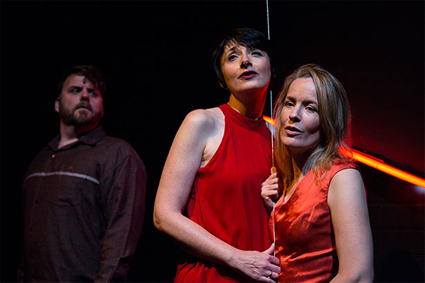
David Rogers-Smith, Judith Dodsworth, Rachael Duncan, From a Black Sky
photo Lorna Sim
David Rogers-Smith, Judith Dodsworth, Rachael Duncan, From a Black Sky
From A Black Sky is a contemporary opera about inflamed passions coming to crisis during the 2003 Canberra bushfires. Lust (too much heat) versus cowardice and inertia (too little of it) play out against the caustic burn of shame, guilt and wounded pride. It’s not revealing too much to say that, as the firestorms approach, a married woman seduces a man’s wife then goads him to suicidal self-sacrifice.
Librettist (Helen Nourse) and composer (Sandra France) have been anxious to make the work melodically and dramatically accessible. It focuses on two couples in a domestic Canberra setting (Saturday markets, retrenchments, unpaid bills, a dithering bureaucracy), yet the score itself raises the stakes and asks significant questions of what contemporary opera is and aims to achieve. Once voices are engaged so powerfully it’s not long before one enters the mythic realm.
The prologue is scored in a lush tonal landscape (with echoes of Ross Edwards) which nonetheless fails to create a specific geography. This matters by the opera’s end, as to my mind (and in the music) the tragedy of, and havoc created by fire, transcends individual lives.
That said, soloist characterizations are strong. In Act 1, Amelia and David’s insistent upper-register As and B flats accentuate his anxiety at being retrenched (to which he can’t openly admit) and her anger at being held back from imminent success. Rippling piano triplet arpeggios underscore their full-throated distress. If Othello is a tragedy about a handkerchief, this is one which turns on a silk dress she wants to market but he won’t finance.
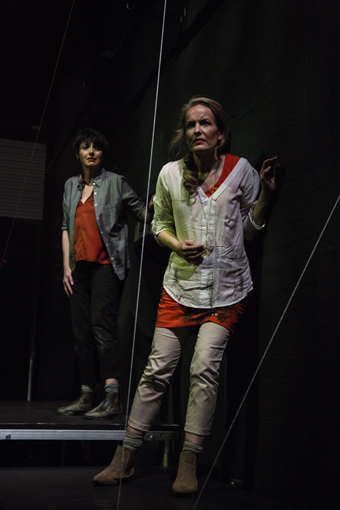
Judith Dodsworth, Rachael Duncan, From a Black Sky
photo Lorna Sim
Judith Dodsworth, Rachael Duncan, From a Black Sky
Sophie’s private seduction of Amelia is, by contrast, scored in mid-range, close-stepped notes above a low, brooding ostenato. She is as intent on her prey as she is later in emasculating Amelia’s husband. The women’s love scene perhaps needed more hunger in its staging; nonetheless, as the firestorm encroaches on the township and David returns, suspicious of the pair, Sophie’s emasculation of him in vocal leaps up and down flattened and sharpened 7ths and 2nds is truly dangerous. She goads him to stay behind—is he a man or not?—whilst the town begins to burn. This is exactly the thing opera does best: weaknesses exposed, greatness by chance—magnified by circumstance. And David Rogers Smith dies beautifully (in lighting designer Gillian Schwab’s impressive fire).
Curiously, this opera by two women becomes a drama about a man’s self-worth, but I am unsure whether this is or should be the central theme. The epilogue exposes how unevenly this is worked through: the other male protagonist is strangely passive just when his own rage, loss or sense of betrayal would surely come to the fore.
Elsewhere, however, I am aware of a tender, feminine register. The chorus’ post-firestorm wailing is extremely delicate, and the comfort meted out by teenagers (“Here, use my phone—ring anyone you want to”) still moves me to tears. Composer and librettist clearly have a delicate partnership and can hold emotional truths within and beneath the blaze demanded by the opera form.
Overall, weaknesses are few, if significant. The racy red motor scooter raffled in the opening scene—an attractor to Sophie’s wealth and manipulative ego, and foil for David who cannot abide the frivolity—needs both stronger staging and longer focus within the score, Sophie perhaps sitting astride the scooter for a whole set piece aria, giving time to set the characterisations, tension and tone. Similarly, the necklace Sophie buys for Amelia, which David can’t afford, is a potent symbol of Amelia’s needs, David’s weakness and Sophie’s power, glossed over in too truncated a form. I read the libretto and score before attending so knew what to look for: others in the audience reported being quite lost.
Some phrases do not carry well from the stage: for example, “I have no urge to stay” is a curiously literary line, veiling rather than demonstrating Amelia’s conflicting impulses; and Tony’s “He was a gutsy man” fails to convey admiration for his mate. The phrase somehow implodes back into the singer’s body, as does “Weston Creek” whose short vowels and clipped consonants do not render a sense of a place we necessarily want to see survive. Perhaps quite critically, the vacuous, gutless bureaucrats who can’t make a decision when it’s most needed would be more effective as a single character, providing dramatic counterpoint and highlighting the ironic, brave folly of David’s lone sacrifice. As in life, ‘faceless’ characters don’t really engage.
These are points crying out for adjustment, but the impact of the whole is to make you want it to be seen again, and not just by Canberra audiences. Although archival ABC radio voiceovers certainly make locals shiver (talk in the foyer redolent of ‘where we were’ on that fateful day), the power of France and Nourse’s work transcends the locale. It is everyman, every woman, any time, every possible fire.
Canberra 100: From A Black Sky, composer Sandra France, librettist Helen Nourse, director Caroline Stacey, conductor, musical director David Kram, designer Christiane Nowak, lighting Gillian Schwab, sound Seth Edwards-Ellis, performer Judith Dodsworth, Don Bemrose, Rachael Duncan, David Rogers Smith, Vocal Ensemble from Erindale College and Arrawang Primary School Chorus; The Street Theatre, Canberra, 20-22 Sept
RealTime issue #117 Oct-Nov 2013 pg. web
© Zsuzsanna Soboslay; for permission to reproduce apply to realtime@realtimearts.net















































































